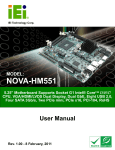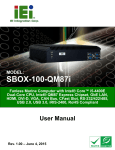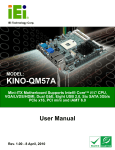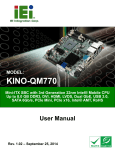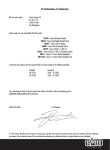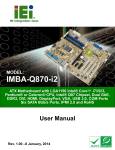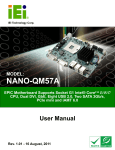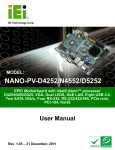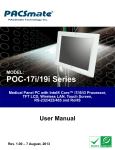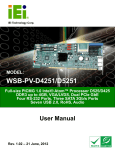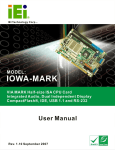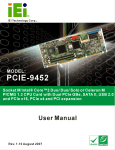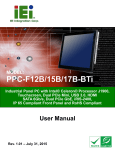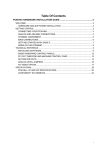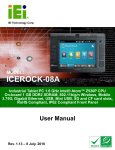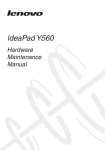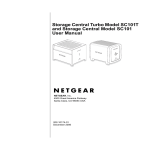Download KINO-HM551 - ICP Deutschland GmbH
Transcript
KINO-HM551 )zKINO-HM551 CPU Card IEI Technology Corp. MODEL: KINO-HM551 Mini-ITX SBC Supports Socket G1 for Intel® mobile Core™ i7/i5/i3 and Intel® Celeron®, VGA/DVI/LVDS/HDMI Display, Dual GbE, Eight USB 2.0, Dual PCIe Mini, Four SATA 3Gb/s, Audio, RoHS User Manual Page I Rev. 1.02 - 15 February, 2012 KINO-HM551 Revision Date Version Changes 15 February, 2012 1.02 Updated Table 3-6: Fan Connector Pinouts 15 September, 2011 1.01 Modified Chapter 3 Connectors 17 November, 2011 1.00 Initial release Page II KINO-HM551 Copyright COPYRIGHT NOTICE The information in this document is subject to change without prior notice in order to improve reliability, design and function and does not represent a commitment on the part of the manufacturer. In no event will the manufacturer be liable for direct, indirect, special, incidental, or consequential damages arising out of the use or inability to use the product or documentation, even if advised of the possibility of such damages. This document contains proprietary information protected by copyright. All rights are reserved. No part of this manual may be reproduced by any mechanical, electronic, or other means in any form without prior written permission of the manufacturer. TRADEMARKS All registered trademarks and product names mentioned herein are used for identification purposes only and may be trademarks and/or registered trademarks of their respective owners. Page III KINO-HM551 Table of Contents 1 INTRODUCTION.......................................................................................................... 1 1.1 INTRODUCTION........................................................................................................... 2 1.2 CONNECTORS ............................................................................................................. 3 1.3 DIMENSIONS ............................................................................................................... 4 1.4 DATA FLOW ................................................................................................................ 5 1.5 TECHNICAL SPECIFICATIONS ...................................................................................... 6 2 UNPACKING ................................................................................................................. 8 2.1 ANTI-STATIC PRECAUTIONS ........................................................................................ 9 2.2 UNPACKING PRECAUTIONS ......................................................................................... 9 2.3 PACKING LIST........................................................................................................... 10 2.3.1 Optional Items...................................................................................................11 3 CONNECTORS ........................................................................................................... 12 3.1 PERIPHERAL INTERFACE CONNECTORS..................................................................... 13 3.1.1 KINO-HM551 Layout ...................................................................................... 13 3.1.2 Peripheral Interface Connectors ..................................................................... 14 3.1.3 External Interface Panel Connectors............................................................... 15 3.2 INTERNAL PERIPHERAL CONNECTORS ...................................................................... 15 3.2.1 Audio Connector .............................................................................................. 15 3.2.2 Digital I/O Connector ...................................................................................... 16 3.2.3 Fan Connector (CPU)...................................................................................... 17 3.2.4 Fan Connector (System) .................................................................................. 17 3.2.5 Front Panel Indicators..................................................................................... 18 3.2.6 Half PCIe Mini Card Slot ................................................................................ 19 3.2.7 Infrared Connector .......................................................................................... 20 3.2.8 Inverter Connector........................................................................................... 21 3.2.9 Keyboard/Mouse Connector ............................................................................ 22 3.2.10 LVDS Connector ............................................................................................ 22 3.2.11 PCIe Mini Card Slot....................................................................................... 23 3.2.12 Power Supply Connector ............................................................................... 25 Page IV KINO-HM551 3.2.13 RS-232/422/485 Serial Port Connector ......................................................... 25 3.2.14 RS-232 Serial Port Connector ....................................................................... 26 3.2.15 SATA Drive Connectors ................................................................................. 27 3.2.16 SATA Power Connectors ................................................................................ 28 3.2.17 SMBus Connector .......................................................................................... 29 3.2.18 SPDIF Connector........................................................................................... 30 3.2.19 TPM Connector.............................................................................................. 31 3.2.20 USB Connectors............................................................................................. 31 3.3 EXTERNAL PERIPHERAL INTERFACE CONNECTOR PANEL ......................................... 32 3.3.1 Adapter Connector........................................................................................... 33 3.3.2 Audio Connector .............................................................................................. 34 3.3.3 Ethernet/USB Connector ................................................................................. 34 3.3.4 HDMI Connector ............................................................................................. 35 3.3.5 Serial Port DB-9 Connector ............................................................................ 36 3.3.6 VGA and DVI Connector ................................................................................. 37 4 INSTALLATION ......................................................................................................... 39 4.1 ANTI-STATIC PRECAUTIONS ...................................................................................... 40 4.2 INSTALLATION CONSIDERATIONS .............................................................................. 41 4.2.1 Installation Notices .......................................................................................... 41 4.3 UNPACKING .............................................................................................................. 42 4.4 CPU, CPU COOLING KIT AND SO-DIMM INSTALLATION ........................................ 42 4.4.1 Socket G1 CPU Installation............................................................................. 43 4.4.2 Socket G1 Cooling Kit Installation .................................................................. 45 4.4.3 SO-DIMM Installation ..................................................................................... 47 4.5 JUMPER SETTINGS .................................................................................................... 47 4.5.1 AT/ATX Power Select Jumper Settings ............................................................ 48 4.5.2 Clear CMOS Jumper........................................................................................ 49 4.5.3 ME RTC Register Jumper ................................................................................ 50 4.5.4 LVDS Voltage Selection.................................................................................... 51 4.5.5 LVDS Screen Resolution Selection................................................................... 52 4.5.6 Serial Port Select Jumper ................................................................................ 53 4.6 CHASSIS INSTALLATION ............................................................................................ 54 4.6.1 Airflow.............................................................................................................. 54 4.6.2 Motherboard Installation................................................................................. 54 Page V KINO-HM551 4.7 INTERNAL PERIPHERAL DEVICE CONNECTIONS ........................................................ 54 4.7.1 Dual RS-232 Cable with Slot Bracket.............................................................. 54 4.7.2 SATA Drive Connection ................................................................................... 55 4.8 EXTERNAL PERIPHERAL INTERFACE CONNECTION ................................................... 57 4.8.1 Audio Connector .............................................................................................. 58 4.8.2 HDMI Display Device Connection .................................................................. 58 4.8.3 LAN Connection............................................................................................... 59 4.8.4 USB Connection............................................................................................... 60 4.8.5 Serial Device Connection ................................................................................ 61 4.8.6 VGA Monitor Connection ................................................................................ 62 4.8.7 DVI Display Device Connection...................................................................... 63 4.9 SOFTWARE INSTALLATION ........................................................................................ 64 5 BIOS SCREENS........................................................................................................... 66 5.1 INTRODUCTION......................................................................................................... 67 5.1.1 Starting Setup................................................................................................... 67 5.1.2 Using Setup ...................................................................................................... 67 5.1.3 Getting Help..................................................................................................... 68 5.1.4 Unable to Reboot After Configuration Changes.............................................. 68 5.1.5 BIOS Menu Bar................................................................................................ 68 5.2 MAIN........................................................................................................................ 69 5.3 ADVANCED ............................................................................................................... 70 5.3.1 ACPI Configuration ......................................................................................... 71 5.3.2 Trusted Computing........................................................................................... 72 5.3.3 CPU Configuration.......................................................................................... 72 5.3.4 SATA Configuration ......................................................................................... 74 5.3.5 USB Configuration........................................................................................... 75 5.3.6 Super IO Configuration ................................................................................... 76 5.3.7 H/W Monitor .................................................................................................... 77 5.3.7.1 Serial Port Console Redirection................................................................ 82 5.3.7.2 Console Redirection Settings.................................................................... 83 5.4 CHIPSET ................................................................................................................... 84 5.4.1 Northbridge Configuration .............................................................................. 85 5.4.2 Southbridge Configuration .............................................................................. 85 5.4.3 Intel IGD SWSCI OpRegion............................................................................. 87 Page VI KINO-HM551 5.5 BOOT........................................................................................................................ 89 5.6 SECURITY ................................................................................................................. 90 5.7 EXIT ......................................................................................................................... 92 A BIOS MENU OPTIONS ............................................................................................. 94 B ONE KEY RECOVERY ............................................................................................. 97 B.1 ONE KEY RECOVERY INTRODUCTION ...................................................................... 98 B.1.1 System Requirement......................................................................................... 99 B.1.2 Supported Operating System ......................................................................... 100 B.2 SETUP PROCEDURE FOR WINDOWS ........................................................................ 101 B.2.1 Hardware and BIOS Setup ............................................................................ 101 B.2.2 Create Partitions ........................................................................................... 102 B.2.3 Install Operating System, Drivers and Applications ..................................... 106 B.2.4 Build-up Recovery Partition.......................................................................... 106 B.2.5 Create Factory Default Image....................................................................... 109 B.3 SETUP PROCEDURE FOR LINUX ...............................................................................114 B.4 RECOVERY TOOL FUNCTIONS .................................................................................117 B.4.1 Factory Restore ..............................................................................................119 B.4.2 Backup System ............................................................................................... 120 B.4.3 Restore Your Last Backup.............................................................................. 121 B.4.4 Manual........................................................................................................... 122 B.5 OTHER INFORMATION ............................................................................................ 122 B.5.1 Using AHCI Mode or ALi M5283 / VIA VT6421A Controller....................... 122 B.5.2 System Memory Requirement ........................................................................ 125 C TERMINOLOGY ..................................................................................................... 126 D WATCHDOG TIMER .............................................................................................. 131 E HAZARDOUS MATERIALS DISCLOSURE ....................................................... 134 E.1 HAZARDOUS MATERIAL DISCLOSURE TABLE FOR IPB PRODUCTS CERTIFIED AS ROHS COMPLIANT UNDER 2002/95/EC WITHOUT MERCURY ..................................... 135 Page VII KINO-HM551 List of Figures Figure 1-1: KINO-HM551 ................................................................................................................2 Figure 1-2: Connectors ..................................................................................................................3 Figure 1-3: KINO-HM551 Dimensions (mm) .................................................................................4 Figure 1-4: Data Flow Block Diagram ...........................................................................................5 Figure 3-1: Connector and Jumper Locations...........................................................................13 Figure 3-2: Audio Connector Location .......................................................................................16 Figure 3-3: Digital I/O Connector Location ................................................................................16 Figure 3-4: Fan Connector Locations.........................................................................................17 Figure 3-5: Fan Connector Locations.........................................................................................18 Figure 3-6: Front Panel Indicator Location ................................................................................18 Figure 3-7: Half PCIe Mini Card Slot Connector Location ........................................................19 Figure 3-8: Infrared Connector Locations..................................................................................21 Figure 3-9: Inverter Connector Location ....................................................................................21 Figure 3-10: Keyboard/Mouse Connector Location ..................................................................22 Figure 3-11: LVDS Connector Locations....................................................................................23 Figure 3-12: PCIe Mini Card Slot Connector Location..............................................................24 Figure 3-13: +12V Power Supply Connector Location..............................................................25 Figure 3-14: RS-232/422/485 Serial Port Location.....................................................................26 Figure 3-15: RS-232 Serial Port Connector Location................................................................27 Figure 3-16: SATA Drive Connector Locations .........................................................................28 Figure 3-17: SATA Power Connector Locations .......................................................................29 Figure 3-18: SMBus Connector Pinout Locations.....................................................................30 Figure 3-19: SPDIF Connector Pinout Locations ......................................................................30 Figure 3-20: TPM1 Connector Location......................................................................................31 Figure 3-21: USB Connector Pinout Locations .........................................................................32 Figure 3-22: KINO-HM551 External Peripheral Interface Connector .......................................33 Figure 3-23: 4-pin Power Mini-DIN Connection .........................................................................33 Figure 3-24: Audio Connector .....................................................................................................34 Figure 3-25: Ethernet Connector.................................................................................................35 Figure 3-26: Serial Port DB-9 Male Connector...........................................................................36 Figure 3-27: VGA Connector .......................................................................................................37 Page VIII KINO-HM551 Figure 4-1: Make sure the CPU socket retention screw is unlocked ......................................44 Figure 4-2: Lock the CPU Socket Retention Screw...................................................................45 Figure 4-3: Cooling Kit Support Bracket ....................................................................................46 Figure 4-4: SO-DIMM Installation ................................................................................................47 Figure 4-5: Jumper Locations .....................................................................................................47 Figure 4-6: AT/ATX Power Select Jumper Location..................................................................49 Figure 4-7: AT Auto Button Select Jumper Settings.................................................................50 Figure 4-8: ME RTC Register Jumper Location.........................................................................51 Figure 4-9: LVDS Voltage Selection Jumper Locations ...........................................................52 Figure 4-10: LVDS Panel Resolution Jumper Pinout Locations..............................................53 Figure 4-11: Serial Port Jumper Location ..................................................................................53 Figure 4-12: Dual RS-232 Cable Installation ..............................................................................55 Figure 4-13: SATA Drive Cable Connection...............................................................................56 Figure 4-14: SATA Power Drive Connection..............................................................................57 Figure 4-15: Audio Connector .....................................................................................................58 Figure 4-16: LAN Connection ......................................................................................................60 Figure 4-17: USB Connector........................................................................................................61 Figure 4-18: Serial Device Connector.........................................................................................62 Figure 4-19: VGA Connector .......................................................................................................63 Figure 4-20: DVI Connector .........................................................................................................64 Figure 4-21: Introduction Screen ................................................................................................65 Figure 4-22: Available Drivers .....................................................................................................65 Figure B-1: IEI One Key Recovery Tool Menu ...........................................................................98 Figure B-2: Launching the Recovery Tool .............................................................................. 103 Figure B-3: Recovery Tool Setup Menu .................................................................................. 103 Figure B-4: Command Mode..................................................................................................... 104 Figure B-5: Partition Creation Commands.............................................................................. 105 Figure B-6: Launching the Recovery Tool .............................................................................. 107 Figure B-7: System Configuration for Windows .................................................................... 107 Figure B-8: Build-up Recovery Partition ................................................................................. 108 Figure B-9: Press any key to continue .................................................................................... 108 Figure B-10: Press F3 to Boot into Recovery Mode............................................................... 109 Figure B-11: Recovery Tool Menu ........................................................................................... 109 Figure B-12: About Symantec Ghost Window ........................................................................ 110 Figure B-13: Symantec Ghost Path ......................................................................................... 110 Page IX KINO-HM551 Figure B-14: Select a Local Source Drive ............................................................................... 111 Figure B-15: Select a Source Partition from Basic Drive ...................................................... 111 Figure B-16: File Name to Copy Image to ............................................................................... 112 Figure B-17: Compress Image.................................................................................................. 112 Figure B-18: Image Creation Confirmation ............................................................................. 113 Figure B-19: Image Creation Complete ................................................................................... 113 Figure B-20: Image Creation Complete ................................................................................... 113 Figure B-21: Press Any Key to Continue ................................................................................ 114 Figure B-22: Partitions for Linux.............................................................................................. 115 Figure B-23: System Configuration for Linux......................................................................... 116 Figure B-24: Access menu.lst in Linux (Text Mode) .............................................................. 116 Figure B-25: Recovery Tool Menu ........................................................................................... 117 Figure B-26: Recovery Tool Main Menu .................................................................................. 118 Figure B-27: Restore Factory Default ...................................................................................... 119 Figure B-28: Recovery Complete Window .............................................................................. 119 Figure B-29: Backup System.................................................................................................... 120 Figure B-30: System Backup Complete Window ................................................................... 120 Figure B-31: Restore Backup ................................................................................................... 121 Figure B-32: Restore System Backup Complete Window ..................................................... 121 Figure B-33: Symantec Ghost Window ................................................................................... 122 Page X KINO-HM551 List of Tables Table 1-1: Technical Specifications..............................................................................................7 Table 3-1: Peripheral Interface Connectors ...............................................................................15 Table 3-2: Rear Panel Connectors ..............................................................................................15 Table 3-3: Audio Connector Pinouts ..........................................................................................16 Table 3-4: Digital I/O Connector Pinouts....................................................................................17 Table 3-5: Fan Connector Pinouts ..............................................................................................17 Table 3-6: Fan Connector Pinouts ..............................................................................................18 Table 3-7: Front Panel Indicator Pinouts....................................................................................19 Table 3-8: Half PCIe Mini Card Slot Pinouts ..............................................................................20 Table 3-9: Infrared Connector Pinouts .......................................................................................21 Table 3-10: Inverter Connector Pinouts .....................................................................................22 Table 3-11: Keyboard/Mouse Connector Pinouts .....................................................................22 Table 3-12: LVDS Connector Pinouts .........................................................................................23 Table 3-13: PCIe Mini Card Slot Pinouts ....................................................................................25 Table 3-14: +12V Power Supply Connector Pinouts .................................................................25 Table 3-15: RS-232/422/485 Serial Port Connector Pinouts .....................................................26 Table 3-16: RS-232 Serial Port Connector Pinouts ...................................................................27 Table 3-17: SATA Drive Connector Pinouts...............................................................................28 Table 3-18: SATA Power Connector Pinouts.............................................................................29 Table 3-19: SMBus Connector Pinouts ......................................................................................30 Table 3-20: SPDIF Connector Pinouts ........................................................................................30 Table 3-21: TPM1 Connector Pinouts .........................................................................................31 Table 3-22: USB Connector Pinouts ...........................................................................................32 Table 3-23: Adapter Connector Pinouts .....................................................................................33 Table 3-24: LAN Connector Pinouts ...........................................................................................35 Table 3-25: USB Connector Pinouts ...........................................................................................35 Table 3-26: HDMI Connector Pinouts .........................................................................................36 Table 3-27: USB Connector Pinouts ...........................................................................................37 Table 3-28: VGA Connector Pinouts...........................................................................................38 Table 3-29: DVI Connector Pinouts.............................................................................................38 Table 4-1: Jumpers .......................................................................................................................48 Page XI KINO-HM551 Table 4-2: AT/ATX Power Select Jumper Settings ....................................................................48 Table 4-3: Clear CMOS Jumper Settings....................................................................................50 Table 4-4: ME RTC Register Jumper Settings ...........................................................................50 Table 4-5: LVDS Voltage Selection Jumper Settings................................................................51 Table 4-6: LVDS Screen Resolution Jumper Settings ..............................................................52 Table 4-7: Serial Port Jumper Settings.......................................................................................53 Table 5-1: BIOS Navigation Keys ................................................................................................68 Page XII KINO-HM551 List of BIOS Menus BIOS Menu 1: Main .......................................................................................................................69 BIOS Menu 2: Advanced ..............................................................................................................70 BIOS Menu 3: ACPI Configuration ..............................................................................................71 BIOS Menu 4: TPM Configuration ...............................................................................................72 BIOS Menu 5: CPU Configuration ...............................................................................................73 BIOS Menu 6: IDE Configuration.................................................................................................74 BIOS Menu 7: USB Configuration ...............................................................................................75 BIOS Menu 8: Super IO Configuration........................................................................................76 BIOS Menu 9: Hardware Health Configuration ..........................................................................77 BIOS Menu 10: Serial Port Console Redirection Menu.............................................................82 BIOS Menu 11: Console Redirection Settings...........................................................................83 BIOS Menu 12: Chipset ................................................................................................................84 BIOS Menu 13:Northbridge Chipset Configuration...................................................................85 BIOS Menu 14:Southbridge Chipset Configuration ..................................................................86 BIOS Menu 15: Intel IGD SWSCI OpRegion ...............................................................................87 BIOS Menu 16: Boot .....................................................................................................................89 BIOS Menu 17: Security ...............................................................................................................90 BIOS Menu 18:Exit........................................................................................................................92 Page XIII KINO-HM551 Chapter 1 1 Introduction Page 1 KINO-HM551 1.1 Introduction Figure 1-1: KINO-HM551 The KINO-HM551 motherboard is a Socket G1 32nm Intel® Core™ i3, i5 and i7 processor platform. One 4.0 GB 800 MHz or 1066 MHz DDR3 SDRAM SO-DIMM is supported by the KINO-HM551. The integrated Intel® HM55 Express Chipset supports two GbE LAN ports through dual Realtek RTL8111E Ethernet controllers (ASF 2.0 support on LAN1). The KINO-HM551 also supports four SATA 3Gb/s drives and provides 5 V SATA power. The KINO-HM551 supports dual display via VGA, HDMI and an internal LVDS connector. Eight USB 2.0 channels and two PCIe Mini expansion sockets provide flexible expansion options. High Definition Audio (HDA) support ensures HDA devices can be easily implemented on the KINO-HM551. Serial device connectivity is provided by three internal RS-232, one external RS-232, and two internal RS-232/422/485 connectors. Page 2 KINO-HM551 1.2 Connectors The connectors on the KINO-HM551 are shown in the figure below. Figure 1-2: Connectors Page 3 KINO-HM551 1.3 Dimensions The dimensions of the board are listed below: Length: 170 mm Width: 170 mm Figure 1-3: KINO-HM551 Dimensions (mm) Page 4 KINO-HM551 1.4 Data Flow Figure 1-4 shows the data flow between the two on-board chipsets and other components 5 installed on the motherboard and described in the following sections of this chapter. Figure 1-4: Data Flow Block Diagram Page 5 KINO-HM551 1.5 Technical Specifications KINO-HM551 technical specifications are listed in table below. Specification KINO-HM551 Form Factor Mini-ITX Socket Socket G1 (rPGA989) Socket 988A CPU Supported 32 nm Intel® Core™ i3 processor 32 nm Intel® Core™ i5 processor 32 nm Intel® Core™ i7 processor (i7 processors without integrated graphics) Intel® Celeron® processor Express Chipset Intel® HM55 Memory Two 204-pin SO-DIMM sockets support 800/1066 MHz 4.0 GB (max.) dual-channel DDR3 SDRAM SO-DIMM (system max. 8GB) Audio Realtek ALC888 HD 7.1 channel audio codec LAN Dual Realtek RTL8111E PCIe GbE controllers with ASF 2.0 support on LAN1 Super I/O Fintek F81865 BIOS AMI uEFI BIOS label Watchdog Timer Software programmable supports 1~255 sec. system reset Expansion PCIe Two PCIe Mini slot I/O Interface Connectors Audio Connector Page 6 One internal audio connector (10-pin header) KINO-HM551 Specification KINO-HM551 Display Ports One VGA port (2048x1536) One HDMI port (up to 1080p) One internal LVDS connector (1600x1200) One DVI-D port (1600x1200) Ethernet Two RJ-45 GbE ports Serial Ports Three RS-232 via three 10-pin headers One external RS-232 serial connector via DB-9 male Two RS-232/422/485 via 14–pin header USB 2.0/1.1 Ports Four external USB ports Four internal USB ports via two 8-pin headers Storage Serial ATA Four SATA 3.0 Gb/s connectors Two 5 V SATA power connectors Environmental and Power Specifications Power Supply 12 V DC input only ATX and AT power supported Power Connector One external DIN 4-pin DC jack One internal 4-pin Molex power connector for power supply Power Consumption [email protected] (2.66 GHz Intel® Core™ i7 620M CPU with two 1333 MHz 4 GB DDR3 SO-DIMM) Operating Temperature -10ºC ~ 60ºC (requires cooler and silicone heat sink paste) Humidity 5% ~ 95% (non-condensing) Physical Specifications Dimensions 170 mm x 170 mm Weight GW/NW 900 g / 450 g Table 1-1: Technical Specifications Page 7 KINO-HM551 Chapter 2 2 Unpacking Page 8 KINO-HM551 2.1 Anti-static Precautions WARNING! Static electricity can destroy certain electronics. Make sure to follow the ESD precautions to prevent damage to the product, and injury to the user. Make sure to adhere to the following guidelines: Wear an anti-static wristband: Wearing an anti-static wristband can prevent electrostatic discharge. Self-grounding: Touch a grounded conductor every few minutes to discharge any excess static buildup. Use an anti-static pad: When configuring any circuit board, place it on an anti-static mat. Only handle the edges of the PCB: Don't touch the surface of the motherboard. Hold the motherboard by the edges when handling. 2.2 Unpacking Precautions When the KINO-HM551 is unpacked, please do the following: Follow the antistatic guidelines above. Make sure the packing box is facing upwards when opening. Make sure all the packing list items are present. Page 9 KINO-HM551 2.3 Packing List NOTE: If any of the components listed in the checklist below are missing, do not proceed with the installation. Contact the IEI reseller or vendor the KINO-HM551 was purchased from or contact an IEI representative directly by sending an email to [email protected]. 32 The KINO-HM551 is shipped with the following components: Quantity Item and Part Number 1 KINO-HM551 motherboard 1 Dual RS-232 cable (P/N: 19800-000112-RS) 2 SATA and power cable (P/N: 32801-000100-100-RS) 1 I/O shielding (P/N: 45014-0032C0-00-RS) 1 Mini jumper pack (2.0mm) (P/N: 33100-000033-RS) 1 Page 10 Utility CD Image sales KINO-HM551 1 One Key Recovery CD 1 Quick Installation Guide 2.3.1 Optional Items The following are optional components which may be separately purchased: Item and Part Number Image CPU cooler for 55 W mobile processor (P/N: CF-989A-RS-R11) Dual USB cable (with bracket) (P/N: CB-USB02-RS) RS-232/422/485 cable (with bracket) (P/N: 19800-000110-RS) SATA to IDE/CompactFlash® converter board (P/N: SAIDE-KIT01-R10) Keyboard/Mouse cable (P/N: 32000-023800-RS) Infineon TPM module (P/N: TPM-IN01-R11) Page 11 KINO-HM551 Chapter 3 3 Connectors Page 12 KINO-HM551 3.1 Peripheral Interface Connectors This chapter details all the jumpers and connectors. 3.1.1 KINO-HM551 Layout The figures below show all the connectors and jumpers. Figure 3-1: Connector and Jumper Locations Page 13 KINO-HM551 3.1.2 Peripheral Interface Connectors The table below lists all the connectors on the board. Connector Type Label Audio connector 10-pin header FRONT-PANEL1 Digital I/O connector 10-pin header DIO1 Fan connector (CPU) 4-pin wafer CPU_FAN1 Fan connector (system) 3-pin wafer SYS_FAN1 Front Panel indicators 10-pin header F_PANEL1 Half PCIe Mini card slot PCIe Mini card slot CN4 Infrared connector 5-pin header IR1 Inverter connector 5-pin wafer INVERTER1 Keyboard and mouse connector 6-pin wafer KB_MS1 LVDS connector 30-pin crimp LVDS1 PCIe Mini card slot PCIe Mini card slot CN3 Power supply connector 4-pin connector PWR2 RS-232/422/485 serial port connector 14-pin header COM4, COM6 RS-232 serial port connector 10-pin header COM2, COM3, COM5 Serial ATA (SATA) drive connector 7-pin SATA S_ATA1, S_ATA2, S_ATA5, S_ATA6 SATA power connector 4-pin wafer CN5, CN6 SMBus connector 4-pin wafer CN7 SPDIF connector 5-pin connector SPDIF1 TPM connector 20-pin connector TPM1 USB connectors 8-pin header USB1, USB2 Page 14 KINO-HM551 Table 3-1: Peripheral Interface Connectors 3.1.3 External Interface Panel Connectors The table below lists the connectors on the external I/O panel. Connector Type Label Adapter connector DC-IN PWR1 Audio connector 2 x Audio jack AUDIO_CV1 Ethernet and USB connector RJ-45, USB port LAN1_USB1, LAN2_USB2 HDMI HDMI port HDMI1 Serial Port DB-9 port connector DB-9 Male COM1 VGA and DVI connector 15-pin Female, VIDEO1 24-pin Female Table 3-2: Rear Panel Connectors 3.2 Internal Peripheral Connectors The section describes all of the connectors on the KINO-HM551. 3.2.1 Audio Connector CN Label: FRONT-PANEL1 CN Type: 10-pin header (2x5) CN Location: See Figure 3-2 CN Pinouts: See Table 3-3 This optional module uses a high quality HDA compatible codec. Page 15 KINO-HM551 Figure 3-2: Audio Connector Location PIN NO. DESCRIPTION PIN NO. DESCRIPTION 1 MIC-L 2 ANALOG GND 3 MIC-R 4 PRESENCE# 5 LINE-R 6 MIC-JD 7 FRONT-10 8 NC 9 LINE-L 10 INE-JD Table 3-3: Audio Connector Pinouts 3.2.2 Digital I/O Connector CN Label: DIO1 CN Type: 10-pin header (2x5) CN Location: See Figure 3-3 CN Pinouts: See Table 3-4 The digital I/O connector provides programmable input and output for external devices. The digital I/O provides 4-bit output and 4-bit input. Figure 3-3: Digital I/O Connector Location PIN NO. DESCRIPTION PIN NO. DESCRIPTION 1 GND 2 VCC 3 Output 3 4 Output 2 5 Output 1 6 Output 0 Page 16 KINO-HM551 PIN NO. DESCRIPTION PIN NO. DESCRIPTION 7 Input 3 8 Input 2 9 Input 1 10 Input 0 Table 3-4: Digital I/O Connector Pinouts 3.2.3 Fan Connector (CPU) CN Label: CPU_FAN1 CN Type: 4-pin wafer (2x2) CN Location: See Figure 3-4 CN Pinouts: See Table 3-5 The fan connector attaches to a cooling fan. Figure 3-4: Fan Connector Locations PIN NO. DESCRIPTION PIN NO. DESCRIPTION 1 GND 2 +12V 3 Rotation Signal 4 PWM Control Signal Table 3-5: Fan Connector Pinouts 3.2.4 Fan Connector (System) CN Label: SYS_FAN1 CN Type: 3-pin wafer CN Location: See Figure 3-5 CN Pinouts: See Table 3-6 The fan connector attaches a cooling fan. Page 17 KINO-HM551 Figure 3-5: Fan Connector Locations PIN NO. DESCRIPTION 1 GND 2 +12V 3 Rotation Signal Table 3-6: Fan Connector Pinouts 3.2.5 Front Panel Indicators CN Label: F_PANEL1 CN Type: 10-pin header CN Location: See Figure 3-6 CN Pinouts: See Table 3-7 The power button connector is connected to a power switch on the system chassis. The reset button connector is connected to a reset switch on the system chassis. Figure 3-6: Front Panel Indicator Location Page 18 KINO-HM551 FUNCTION PIN NO. DESCRIPTION FUNCTION PIN NO. DESCRIPTION 1 NC Power LED 6 PWR_LED+ 2 PWR_BTN+ Indicator 7 PWR_LED+ 3 PWR_BTN- 8 PWR_LED- HDD LED 4 HDD_LED+ 9 RESET+ Indicator 5 HDD_LED- 10 RESET- Power Button Reset Table 3-7: Front Panel Indicator Pinouts 3.2.6 Half PCIe Mini Card Slot CN Label: CN4 CN Type: PCIe Mini card slot CN Location: See Figure 3-7 CN Pinouts: See Table 3-8 The PCIe Mini card slot is for installing PCIe Mini expansion cards. Figure 3-7: Half PCIe Mini Card Slot Connector Location PIN NO. DESCRIPTION PIN NO. DESCRIPTION 1 PCIE_WAKE# 2 VCC3 3 N/C 4 GND 5 N/C 6 1.5 V 7 N/C 8 N/C 9 GND 10 N/C 11 CLK- 12 N/C 13 CLK+ 14 N/C 15 GND 16 N/C 17 PCIRST# 18 GND 19 N/C 20 VCC3 Page 19 KINO-HM551 PIN NO. DESCRIPTION PIN NO. DESCRIPTION 21 GND 22 PCIRST# 23 PERN2 24 3VDual 25 PERP2 26 GND 27 GND 28 1.5 V 29 GND 30 SMBCLK 31 PETN2 32 SMBDATA 33 PETP2 34 GND 35 GND 36 USBD- 37 N/C 38 USBD+ 39 N/C 40 GND 41 N/C 42 N/C 43 N/C 44 N/C 45 N/C 46 N/C 47 N/C 48 1.5 V 49 N/C 50 GND 51 N/C 52 VCC3 Table 3-8: Half PCIe Mini Card Slot Pinouts 3.2.7 Infrared Connector CN Label: IR1 CN Type: 5-pin header CN Location: See Figure 3-8 CN Pinouts: See Table 3-9 The infrared connector attaches to an infrared receiver for use with remote controls. Page 20 KINO-HM551 Figure 3-8: Infrared Connector Locations PIN NO. DESCRIPTION PIN NO. DESCRIPTION 1 GND 2 +5V 3 Output 3 4 Output 2 5 Output 1 6 Output 0 7 Input 3 8 Input 2 9 Input 1 10 Input 0 Table 3-9: Infrared Connector Pinouts 3.2.8 Inverter Connector CN Label: INVERTER1 CN Type: 5-pin wafer CN Location: See Figure 3-9 CN Pinouts: See Table 3-10 The inverter connector provides power to an LCD panel. Figure 3-9: Inverter Connector Location PIN NO. DESCRIPTION 1 BRIGHTNESS 2 GROUND Page 21 KINO-HM551 PIN NO. DESCRIPTION 3 +12V 4 GROUND 5 BACKLIGHT ENABLE Table 3-10: Inverter Connector Pinouts 3.2.9 Keyboard/Mouse Connector CN Label: KB_MS1 CN Type: 6-pin wafer CN Location: See Figure 3-10 CN Pinouts: See Table 3-11 The keyboard/mouse connector connects to a PS/2 Y-cable that can be connected to a PS/2 keyboard and mouse. Figure 3-10: Keyboard/Mouse Connector Location PIN NO. DESCRIPTION 1 VCC5_KBMS 2 MSDATA 3 MSCLK 4 KBDATA 5 KBCLK 6 KBGND Table 3-11: Keyboard/Mouse Connector Pinouts 3.2.10 LVDS Connector CN Label: Page 22 LVDS1 KINO-HM551 CN Type: 30-pin crimp (2x15) CN Location: See Figure 3-11 CN Pinouts: See Table 3-12 5 The LVDS connector is for an LCD panel connected to the board. Figure 3-11: LVDS Connector Locations PIN NO. DESCRIPTION PIN NO. DESCRIPTION 1 GND 2 GND 3 A_Y0 4 A_Y0# 5 A_Y1 6 A_Y1# 7 A_Y2 8 A_Y2# 9 A_CK 10 A_CK# 11 A_Y3 12 A_Y3# 13 GND 14 GND 15 B_Y0 16 B_Y0# 17 B_Y1 18 B_Y1# 19 B_Y2 20 B_Y2# 21 B_CK 22 B_CK# 23 B_Y3 24 B_Y3# 25 GND 26 GND 27 VCC/VCC3 28 VCC/VCC3 29 VCC/VCC3 30 VCC/VCC3 Table 3-12: LVDS Connector Pinouts 3.2.11 PCIe Mini Card Slot CN Label: CN3 Page 23 KINO-HM551 CN Type: PCIe Mini card slot CN Location: See Figure 3-12 CN Pinouts: See Table 3-13 The PCIe Mini card slot is for installing PCIe Mini expansion cards. Figure 3-12: PCIe Mini Card Slot Connector Location PIN NO. DESCRIPTION PIN NO. DESCRIPTION 1 PCIE_WAKE# 2 VCC3 3 N/C 4 GND 5 N/C 6 1.5 V 7 N/C 8 N/C 9 GND 10 N/C 11 CLK- 12 N/C 13 CLK+ 14 N/C 15 GND 16 N/C 17 PCIRST# 18 GND 19 N/C 20 VCC3 21 GND 22 PCIRST# 23 PERN2 24 3VDual 25 PERP2 26 GND 27 GND 28 1.5 V 29 GND 30 SMBCLK 31 PETN2 32 SMBDATA 33 PETP2 34 GND Page 24 KINO-HM551 PIN NO. DESCRIPTION PIN NO. DESCRIPTION 35 GND 36 USBD- 37 N/C 38 USBD+ 39 N/C 40 GND 41 N/C 42 N/C 43 N/C 44 N/C 45 N/C 46 N/C 47 N/C 48 1.5 V 49 N/C 50 GND 51 N/C 52 VCC3 Table 3-13: PCIe Mini Card Slot Pinouts 3.2.12 Power Supply Connector CN Label: PWR2 CN Type: 4-pin connector (2x2) CN Location: See Figure 3-13 CN Pinouts: See Table 3-14 6 The Power Supply connector provides +12 V power output. Figure 3-13: +12V Power Supply Connector Location PIN NO. DESCRIPTION PIN NO. DESCRIPTION 1 GND 2 GND 3 +12V 4 +12V Table 3-14: +12V Power Supply Connector Pinouts 3.2.13 RS-232/422/485 Serial Port Connector CN Label: COM4, COM6 Page 25 KINO-HM551 CN Type: 14-pin header CN Location: See Figure 3-14 CN Pinouts: See Table 3-15 6 This connector provides RS-232, RS-422, or RS-485 communications. Figure 3-14: RS-232/422/485 Serial Port Location PIN NO. DESCRIPTION 1 DATA CARRIER DETECT (DCD) 2 DATA SET READY (DSR) 3 RECEIVE DATA (RXD) 4 REQUEST TO SEND (RTS) 5 TRANSMIT DATA (TXD) 6 CLEAR TO SEND (CTS) 7 DATA TERMINAL READY (DTR) 8 RING INDICATOR (RI) 9 GND (GND) 10 GND (GND) 11 TXD485+ 12 TXD485# 13 RXD485+ 14 RXD485# Table 3-15: RS-232/422/485 Serial Port Connector Pinouts 3.2.14 RS-232 Serial Port Connector CN Label: Page 26 COM2, COM3, COM5 KINO-HM551 CN Type: 10-pin header CN Location: See Figure 3-15 CN Pinouts: See Table 3-16 The connector supports three internal high speed UARTs. Figure 3-15: RS-232 Serial Port Connector Location PIN NO DESCRIPTION 1 DCD 2 DSR 3 SIN 4 RTS 5 SOUT 6 CTS 7 DTR 8 XRI 9 GND 10 GND Table 3-16: RS-232 Serial Port Connector Pinouts 3.2.15 SATA Drive Connectors CN Label: S_ATA1, S_ATA2, S_ATA5, S_ATA6 CN Type: 7-pin SATA drive connectors Page 27 KINO-HM551 CN Location: See Figure 3-16 CN Pinouts: See Table 3-17 6 6 The four SATA 3Gb/s drive connectors are each connected to a SATA 3Gb/s drive. The SATA 3Gb/s drives transfer data at speeds as high as 3.0 Gb/s. Figure 3-16: SATA Drive Connector Locations PIN NO. DESCRIPTION 1 GND 2 TX+ 3 TX- 4 GND 5 RX- 6 RX+ 7 GND Table 3-17: SATA Drive Connector Pinouts 3.2.16 SATA Power Connectors CN Label: CN5, CN6 CN Type: 4-pin wafer CN Location: See Figure 3-17 CN Pinouts: See Table 3-18 Page 28 KINO-HM551 The SATA Power Connectors provides +5V power output on Pin 1 and +12V power output on Pin 4 to the SATA connectors. Figure 3-17: SATA Power Connector Locations PIN NO. DESCRIPTION 1 +5V (Supports 1A) 2 GND 3 GND 4 +12V (Supports 1A) Table 3-18: SATA Power Connector Pinouts 3.2.17 SMBus Connector CN Label: CN7 CN Type: 4-pin wafer CN Location: See Figure 3-18 CN Pinouts: See Table 3-19 6 6 The SMBus (System Management Bus) connector provides low-speed system management communications. Page 29 KINO-HM551 Figure 3-18: SMBus Connector Pinout Locations PIN NO. DESCRIPTION 1 GND 2 SDAT 3 SCLK 4 +5V Table 3-19: SMBus Connector Pinouts 3.2.18 SPDIF Connector CN Label: SPDIF1 CN Type: 5-pin connector CN Location: See Figure 3-19 CN Pinouts: See Table 3-20 6 6 This connector is used to connect digital audio devices to the system. Figure 3-19: SPDIF Connector Pinout Locations PIN NO. DESCRIPTION 1 5V 2 NC 3 SPDIFOUT 4 GND 5 SPDIFIN Table 3-20: SPDIF Connector Pinouts Page 30 KINO-HM551 3.2.19 TPM Connector CN Label: TPM1 CN Type: 20-pin connector CN Location: See Figure 3-20 CN Pinouts: See Table 3-21 The Trusted Platform Module (TPM) connector secures the system on bootup. Figure 3-20: TPM1 Connector Location PIN NO. DESCRIPTION PIN NO. DESCRIPTION 1 LCLK 2 GND 3 LFRAME# 4 KEY 5 LRERST# 6 +5V 7 LAD3 8 LAD2 9 +3V 10 LAD1 11 LAD0 12 GND 13 SCL 14 SDA 15 SB3V 16 SERIRQ 17 GND 18 GLKRUN# 19 LPCPD# 20 LDRQ# Table 3-21: TPM1 Connector Pinouts 3.2.20 USB Connectors CN Label: USB1 and USB2 CN Type: 8-pin header (2x4) CN Location: See Figure 3-21 6 Page 31 KINO-HM551 CN Pinouts: See Table 3-22 6 The USB connectors connect to USB devices. Each pin header provides two USB ports. Figure 3-21: USB Connector Pinout Locations PIN NO. DESCRIPTION PIN NO. DESCRIPTION 1 VCC 2 GND 3 DATAN- 4 DATA1M+ 5 DATAN+ 6 DATAM- 7 GND 8 VCC Table 3-22: USB Connector Pinouts 3.3 External Peripheral Interface Connector Panel Figure 3-22 shows the KINO-HM551 external peripheral interface connector (Mini-ITX 6 SBC) panel. The KINO-HM551 Mini-ITX SBC panel consists of the following: Page 32 2 x Ethernet connectors 1 x HDMI connectors 1 x DB-9 RS-232 connector 4 x USB connectors 1 x 12 V adapter connector 1 x VGA connector 1 x DVI connector 1 x Audio connector KINO-HM551 Figure 3-22: KINO-HM551 External Peripheral Interface Connector 3.3.1 Adapter Connector CN Label: PWR1 CN Type: DC-IN CN Location: See Figure 3-23 CN Pinouts: See Table 3-23 6 6 Figure 3-23: 4-pin Power Mini-DIN Connection PIN NO. DESCRIPTION 1 12V 2 GND 3 12V 4 GND 5 GND Table 3-23: Adapter Connector Pinouts Page 33 KINO-HM551 3.3.2 Audio Connector CN Label: AUDIO_CV1 CN Type: 2 x Audio jack CN Pinouts: See Figure 3-24 6 The audio jacks connect to external audio devices. Line Out port (Lime): Connects to a headphone or a speaker. With multi-channel configurations, this port can also connect to front speakers. Microphone (Pink): Connects a microphone. Figure 3-24: Audio Connector 3.3.3 Ethernet/USB Connector CN Label: LAN1_USB1 and LAN2_USB2 CN Type: RJ-45 and USB port CN Location: See Figure 3-25 CN Pinouts: See Table 3-24 and Table 3-25 6 6 The KINO-HM551 is equipped with two built-in RJ-45 Ethernet controllers. Each controller can connect to the LAN through one RJ-45 LAN connector. Page 34 KINO-HM551 Figure 3-25: Ethernet Connector PIN NO. DESCRIPTION PIN NO. DESCRIPTION 1 RED 2 GREEN 3 BLUE 4 NC 5 GND 6 GND 7 GND 8 GND 9 VCC 10 GND 11 NC 12 DDCDAT 13 HSYNC 14 VSYNC 15 DDCCLK Table 3-24: LAN Connector Pinouts PIN NO. DESCRIPTION 1 VCC 2 DATA- 3 DATA+ 4 GND Table 3-25: USB Connector Pinouts 3.3.4 HDMI Connector CN Label: HDMI1 CN Type: HDMI type A connector CN Pinouts: See Table 3-26 6 The HDMI (High-Definition Multimedia Interface) connector connects to digital audio or video sources. Page 35 KINO-HM551 PIN NO. DESCRIPTION PIN NO. DESCRIPTION 1 HDMI_DATA2 13 N/C 2 GND 14 N/C 3 HDMI_DATA2# 15 HDMI_SCL 4 HDMI_DATA1 16 HDMI_SDA 5 GND 17 GND 6 HDMI_DATA1# 18 +5V 7 HDMI_DATA0 19 HDMI_HPD 8 GND 20 HDMI_GND 9 HDMI_DATA0# 21 HDMI_GND 10 HDMI_CLK 22 HDMI_GND 11 GND 23 HDMI_GND 12 HDMI_CLK# Table 3-26: HDMI Connector Pinouts 3.3.5 Serial Port DB-9 Connector CN Label: COM1 CN Type: DB-9 Male CN Location: See Figure 3-26 CN Pinouts: See Table 3-27 6 6 The KINO-HM551 offers one external high speed UART port for a DB-9 female cable. Figure 3-26: Serial Port DB-9 Male Connector Page 36 KINO-HM551 PIN NO. DESCRIPTION 1 DATA CARRIER DETECT (DCD1) 2 RECEIVE DATA (RXD1) 3 TRANSMIT DATA (TXD1) 4 DATA TERMINAL READY (DTR1) 5 GND (GND1) 6 DATA SET READY (DSR1) 7 REQUEST TO SEND (RTS1) 8 CLEAR TO SEND (CTS1) 9 RING INDICATOR (RI1) Table 3-27: USB Connector Pinouts 3.3.6 VGA and DVI Connector CN Label: VIDEO1 CN Type: 15-pin Female (VGA) , 24-pin Female (DVI) CN Location: See Figure 3-27 CN Pinouts: Table 3-28 and Table 3-29 This port connects to a monitor that accepts a standard VGA input. Figure 3-27: VGA Connector PIN NO. DESCRIPTION PIN NO. DESCRIPTION 1 RED 2 GREEN 3 BLUE 4 NC 5 GND 6 GND 7 GND 8 GND 9 VCC 10 GND Page 37 KINO-HM551 PIN NO. DESCRIPTION PIN NO. DESCRIPTION 11 NC 12 DDCDAT 13 HSYNC 14 VSYNC 15 DDCCLK Table 3-28: VGA Connector Pinouts The DVI (Digital Visual Interface) port connects to a monitor that supports DVI video input. PIN NO. DESCRIPTION PIN NO. DESCRIPTION 1 DVI signal differential pair (2-) 2 DVI signal differential pair (2+) 3 GND 4 DVI signal differential pair (4-) 5 DVI signal differential pair (4+) 6 DDCLCK 7 DDCDATA 8 N/C 9 DVI signal differential pair (1-) 10 DVI signal differential pair (1+) 11 GND 12 DVI signal differential pair (3-) 13 DVI signal differential pair (3+) 14 5V supply 15 GND 16 Hot plug detect 17 DVI signal differential pair (0-) 18 DVI signal differential pair (0+) 19 GND 20 DVI signal differential pair (5-) 21 DVI signal differential pair (5+) 22 GND 23 DVI CLK(+) 24 DVI CLK(-) Table 3-29: DVI Connector Pinouts Page 38 KINO-HM551 Chapter 4 4 Installation Page 39 KINO-HM551 4.1 Anti-static Precautions WARNING: Failure to take ESD precautions during the installation of the KINO-HM551 may result in permanent damage to the KINO-HM551 and severe injury to the user. Electrostatic discharge (ESD) can cause serious damage to electronic components, including the KINO-HM551. Dry climates are especially susceptible to ESD. It is therefore critical that whenever the KINO-HM551 or any other electrical component is handled, the following anti-static precautions are strictly adhered to. Wear an anti-static wristband: Wearing a simple anti-static wristband can help to prevent ESD from damaging the board. Self-grounding: Before handling the board, touch any grounded conducting material. During the time the board is handled, frequently touch any conducting materials that are connected to the ground. Use an anti-static pad: When configuring the KINO-HM551, place it on an antic-static pad. This reduces the possibility of ESD damaging the KINO-HM551. Only handle the edges of the PCB: When handling the PCB, hold the PCB by the edges. Page 40 KINO-HM551 4.2 Installation Considerations NOTE: The following installation notices and installation considerations should be read and understood before the KINO-HM551 is installed. All installation notices pertaining to the installation of the KINO-HM551 should be strictly adhered to. Failing to adhere to these precautions may lead to severe damage of the KINO-HM551 and injury to the person installing the motherboard. 4.2.1 Installation Notices WARNING: The installation instructions described in this manual should be carefully followed in order to prevent damage to the KINO-HM551, KINO-HM551 components and injury to the user. Before and during the installation please DO the following: Read the user manual: o The user manual provides a complete description of the KINO-HM551 installation instructions and configuration options. Wear an electrostatic discharge cuff (ESD): o Electronic components are easily damaged by ESD. Wearing an ESD cuff removes ESD from the body and helps prevent ESD damage. Place the KINO-HM551 on an antistatic pad: o When installing or configuring the motherboard, place it on an antistatic pad. This helps to prevent potential ESD damage. Turn all power to the KINO-HM551 off: Page 41 KINO-HM551 o When working with the KINO-HM551, make sure that it is disconnected from all power supplies and that no electricity is being fed into the system. Before and during the installation of the KINO-HM551 DO NOT: Remove any of the stickers on the PCB board. These stickers are required for warranty validation. Use the product before verifying all the cables and power connectors are properly connected. Allow screws to come in contact with the PCB circuit, connector pins, or its components. 4.3 Unpacking When the KINO-HM551 is unpacked, please check all the unpacking list items listed in Chapter 3 are indeed present. If any of the unpacking list items are not available please contact the KINO-HM551 vendor reseller/vendor where the KINO-HM551 was purchased or contact an IEI sales representative. 4.4 CPU, CPU Cooling Kit and SO-DIMM Installation WARNING: A CPU should never be turned on without the specified cooling kit being installed. If the cooling kit (heat sink and fan) is not properly installed and the system turned on, permanent damage to the CPU, KINO-HM551 and other electronic components attached to the system may be incurred. Running a CPU without a cooling kit may also result in injury to the user. The CPU, CPU cooling kit and DIMM are the most critical components of the KINO-HM551. If one of these component is not installed the KINO-HM551 cannot run. Page 42 KINO-HM551 4.4.1 Socket G1 CPU Installation WARNING: CPUs are expensive and sensitive components. When installing the CPU please be careful not to damage it in anyway. Make sure the CPU is installed properly and ensure the correct cooling kit is properly installed. To install a socket G1 CPU onto the KINO-HM551, follow the steps below: WARNING: When handling the CPU, only hold it on the sides. DO NOT touch the pins at the bottom of the CPU. Step 1: Unlock the CPU retention screw. When shipped, the retention screw of the CPU socket should be in the unlocked position. If it is not in the unlocked position, use a screwdriver to unlock the screw. See Figure 4-1. Page 43 KINO-HM551 Figure 4-1: Make sure the CPU socket retention screw is unlocked Step 2: Inspect the CPU socket. Make sure there are no bent pins and make sure the socket contacts are free of foreign material. If any debris is found, remove it with compressed air. Step 3: Correctly Orientate the CPU. Make sure the IHS (integrated heat sink) side is facing upwards. Step 4: Correctly position the CPU. Match the Pin 1 mark with the cut edge on the CPU socket. See Figure 4-1. Step 5: Align the CPU pins. Carefully align the CPU pins with the holes in the CPU socket. Step 6: Insert the CPU. Gently insert the CPU into the socket. If the CPU pins are properly aligned, the CPU should slide into the CPU socket smoothly. Step 7: Lock the retention screw. Rotate the retention screw into the locked position. See Figure 4-2. Page 44 KINO-HM551 Figure 4-2: Lock the CPU Socket Retention Screw 4.4.2 Socket G1 Cooling Kit Installation An IEI Socket G1 CPU cooling kit can be purchased separately. (See Chapter 3) The cooling kit comprises a CPU heat sink and a cooling fan. WARNING: Do not wipe off (accidentally or otherwise) the pre-sprayed layer of thermal paste on the bottom of the heat sink. The thermal paste between the CPU and the heat sink is important for optimum heat dissipation. To install the cooling kit, please follow the steps below. Step 1: Install the cooling kit bracket. A cooling kit bracket is installed on the rear of the motherboard. Align the bracket with the four retention holes at the back of the motherboard. Once properly aligned, insert four retention screws from the front of the motherboard. Page 45 KINO-HM551 Figure 4-3: Cooling Kit Support Bracket Step 2: Open the lever at the top of the heat sink. Lift the lever at the top of the cooling kit to loosen the cooling kit clamps. Step 3: Secure the cooling kit. Gently place the heat sink and cooling kit onto the CPU. Make sure the hooks are properly secured to the bracket. To secure the cooling kit, close the top lever. Step 4: Connect the fan cable. Connect the cooling kit fan cable to the fan connector on the KINO-HM551. Carefully route the cable and avoid heat generating chips and fan blades. Page 46 KINO-HM551 4.4.3 SO-DIMM Installation To install an SO-DIMM, please follow the steps below and refer to Figure 4-4. Figure 4-4: SO-DIMM Installation Step 1: Locate the SO-DIMM socket. Place the board on an anti-static mat. Step 2: Align the SO-DIMM with the socket. Align the notch on the memory with the notch on the memory socket. Step 3: Insert the SO-DIMM. Push the memory in at a 20º angle. (See Figure 4-4) Step 4: Seat the SO-DIMM. Gently push downwards and the arms clip into place. (See Figure 4-4) 4.5 Jumper Settings NOTE: A jumper is a metal bridge used to close an electrical circuit. It consists of two or three metal pins and a small metal clip (often protected by a plastic cover) that slides over the pins to connect them. To CLOSE/SHORT a jumper means connecting the pins of the jumper with the plastic clip and to OPEN a jumper means removing the plastic clip from a jumper. Figure 4-5: Jumper Locations Page 47 KINO-HM551 Before the KINO-HM551 is installed in the system, the jumpers must be set in accordance with the desired configuration. The jumpers on the KINO-HM551 are listed in Table 4-1. 6 Description Type Label AT/ATX power select 3-pin header J_ATXCTL1 Clear CMOS 3-pin header J_CMOS1 ME RTC Register 3-pin header ME_RTC1 LVDS voltage selection 3-pin header J_VLVDS1 LVDS panel resolution 8-pin header J_PID1 8-pin header JP2, JP3 selection Serial Port Mode setting Table 4-1: Jumpers 4.5.1 AT/ATX Power Select Jumper Settings Jumper Label: J_ATXCTL1 Jumper Type: 3-pin header Jumper Settings: See Table 4-2 Jumper Location: See Figure 4-6 6 6 The AT/ATX Power Select jumper specifies the systems power mode as AT or ATX. AT/ATX Power Select jumper settings are shown in Table 4-2. 6 AT Power Select Description Short 1 - 2 Use ATX power Short 2 - 3 Use AT power Default Table 4-2: AT/ATX Power Select Jumper Settings The location of the AT/ATX Power Select jumper is shown in Figure 4-6 below. 6 Page 48 KINO-HM551 Figure 4-6: AT/ATX Power Select Jumper Location 4.5.2 Clear CMOS Jumper Jumper Label: J_CMOS1 Jumper Type: 3-pin header Jumper Settings: See Table 4-3 Jumper Location: See Figure 4-7 If the KINO-HM551 fails to boot due to improper BIOS settings, the clear CMOS jumper clears the CMOS data and resets the system BIOS information. To do this, use the jumper cap to close pins 2 and 3 for a few seconds then reinstall the jumper clip back to pins 1 and 2. If the “CMOS Settings Wrong” message is displayed during the boot up process, the fault may be corrected by pressing the F1 to enter the CMOS Setup menu. Do one of the following: Enter the correct CMOS setting Load Optimal Defaults Load Failsafe Defaults. After having done one of the above, save the changes and exit the CMOS Setup menu. The clear CMOS jumper settings are shown in Table 4-3. Page 49 KINO-HM551 Clear CMOS Description Short 1-2 Keep CMOS Setup Short 2-3 Clear CMOS Setup Default Table 4-3: Clear CMOS Jumper Settings The location of the clear CMOS jumper is shown in Figure 4-5 Figure 4-7: AT Auto Button Select Jumper Settings 4.5.3 ME RTC Register Jumper Jumper Label: ME_RTC1 Jumper Type: 3-pin header Jumper Settings: See Table 4-4 Jumper Location: See Figure 4-8 The ME RTC Register jumper saves or clears the ME RTC registers. The ME RTC Register jumper settings are shown in Table 4-4. Setting Description Short 1 - 2 Save ME RTC registers Short 2 – 3 Default Clear ME RTC registers Table 4-4: ME RTC Register Jumper Settings The location of the ME RTC Register jumper is shown in Figure 4-8 below. Page 50 KINO-HM551 Figure 4-8: ME RTC Register Jumper Location 4.5.4 LVDS Voltage Selection WARNING: Incorrect voltages can destroy the LCD panel. Make sure to select a voltage that matches the voltage required by the LCD panel. Jumper Label: J_VLVDS1 Jumper Type: 3-pin header Jumper Settings: See Table 4-5 Jumper Location: See Figure 4-9 The LCD voltage selection jumper sets the voltage of the power supplied to the LCD panel. Setting Description Short 1-2 Set The Voltage Level Of Panel To VCC3 Short 3-4 Set The Voltage Level Of Panel To VCC Table 4-5: LVDS Voltage Selection Jumper Settings Page 51 KINO-HM551 Figure 4-9: LVDS Voltage Selection Jumper Locations 4.5.5 LVDS Screen Resolution Selection Jumper Label: J_PID1 Jumper Type: 8-pin header Jumper Settings: See Table 4-6 Jumper Location: See Figure 4-10 The LVDS Screen Resolution Selection jumper allows the LVDS screen voltage to be set. The LVDS Screen Resolution Selection jumper settings are shown in Table 4-2. Setting Description Open 800 X 600 (18bit) Short 1-2 1024 X 768 (18bit) Short 3-4 1024 X 768 (24bit) Short 1-2, 3-4 1280 X 800 (18bit) Short 5-6 1280 X 1024 (48bit) Short 1-2, 5-6 1366 X 768 (18bit) Short 3-4, 5-6 1400 X 1050 (48bit) Short 1-2, 2-4, 5-6 1440X 900 (48bit) Short 7-8 1600 X 900 (48bit) Short 1-2, 7-8 1600 X 1200 (48bit) Short 3-4, 7-8 1680X 1050 (48bit) Short 1-2, 3-4, 7-8 1920 X 1080 (48bit) Short 5-6, 7-8 1920 X 1200 (48bit) Short 1-2, 5-6, 7-8 2048 X 1536 (48bit) Default Table 4-6: LVDS Screen Resolution Jumper Settings Page 52 KINO-HM551 Figure 4-10: LVDS Panel Resolution Jumper Pinout Locations 4.5.6 Serial Port Select Jumper Jumper Label: JP2, JP3 Jumper Type: 8-pin header Jumper Settings: See Table 4-7 Jumper Location: See Figure 4-11 This jumper sets the communication protocol of the serial port. Setting Description Short 1-2 RS-232 Short 3-4 RS-422 Short 5-6 RS-485 Short 7-8 RS-485 with RTS Control Default Table 4-7: Serial Port Jumper Settings Figure 4-11: Serial Port Jumper Location Page 53 KINO-HM551 4.6 Chassis Installation 4.6.1 Airflow WARNING: Airflow is critical to the cooling of the CPU and other onboard components. The chassis in which the KINO-HM551 must have air vents to allow cool air to move into the system and hot air to move out. The KINO-HM551 must be installed in a chassis with ventilation holes on the sides allowing airflow to travel through the heat sink surface. In a system with an individual power supply unit, the cooling fan of a power supply can also help generate airflow through the board surface. 4.6.2 Motherboard Installation To install the KINO-HM551 motherboard into the chassis please refer to the reference material that came with the chassis. 4.7 Internal Peripheral Device Connections This section outlines the installation of peripheral devices to the onboard connectors 4.7.1 Dual RS-232 Cable with Slot Bracket The dual RS-232 cable slot connector consists of two connectors attached to two independent cables. Each cable is then attached to a D-sub 9 male connector that is mounted onto a slot. To install the dual RS-232 cable, please follow the steps below. Step 5: Locate the connectors. The locations of the RS-232 connectors are shown in Chapter 3. Step 6: Insert the cable connectors. Insert one connector into each serial port box headers. See Figure 4-12. A key on the front of the cable connectors ensures the connector can only be installed in one direction. Page 54 KINO-HM551 Figure 4-12: Dual RS-232 Cable Installation Secure the bracket. The dual RS-232 connector has two D-sub 9 male connectors secured on a bracket. To secure the bracket to the chassis please refer to the reference material that came with the chassis. 4.7.2 SATA Drive Connection The KINO-HM551 is shipped with two SATA drive cables and one SATA drive power cable. To connect the SATA drives to the connectors, please follow the steps below. Step 7: Locate the connectors. The locations of the SATA drive connectors are shown in Chapter 3. Step 8: Insert the cable connector. Press the clip on the connector at the end of the SATA cable and insert the cable connector into the on-board SATA drive connector. Page 55 KINO-HM551 Figure 4-13: SATA Drive Cable Connection Step 9: Connect the cable to the SATA disk. Connect the connector on the other end of the cable to the connector at the back of the SATA drive. See Figure 4-14. Step 10: Connect the SATA power cable. Connect the SATA power connector to the back of the SATA drive. See Figure 4-14. Step 0: Page 56 KINO-HM551 Figure 4-14: SATA Power Drive Connection 4.8 External Peripheral Interface Connection The following external peripheral devices can be connected to the external peripheral interface connectors. Audio devices HDMI devices RJ-45 Ethernet cable connector USB devices Serial port devices VGA monitor DVI devices To install these devices, connect the corresponding cable connector from the actual device to the corresponding KINO-HM551 external peripheral interface connector making sure the pins are properly aligned. Page 57 KINO-HM551 4.8.1 Audio Connector The audio jacks on the external audio connector enable the KINO-HM551 to be connected to a stereo sound setup. To install the audio devices, follow the steps below. Step 1: Identify the audio plugs. The plugs on your home theater system or speakers may not match the colors on the rear panel. If audio plugs are plugged into the wrong jacks, sound quality will be very bad. Step 2: Plug the audio plugs into the audio jacks. Plug the audio plugs into the audio jacks. If the plugs on your speakers are different, an adapter will need to be used to plug them into the audio jacks. Line Out port (Lime): Connects to a headphone or a speaker. Microphone (Pink): Connects to a microphone. Figure 4-15: Audio Connector Step 3: Check audio clarity. Check that the sound is coming through the right speakers by adjusting the balance front to rear and left to right. 4.8.2 HDMI Display Device Connection The KINO-HM551 has one female HDMI connector on the external peripheral interface panel. The HDMI connectors are connected to digital display devices. To connect a digital display device to the KINO-HM551, please follow the instructions below. Page 58 KINO-HM551 Step 1: Locate the HDMI connector. The location of the HDMI connector is shown in another chapter. Step 2: Align the HDMI connector. Align the male HDMI connector on the digital display device cable with the female HDMI connector on the external peripheral interface. Step 3: Insert the HDMI connector. Once the connectors are properly aligned with the male connector, insert the male connector from the digital display device into the female connector on the KINO-HM551. Step 4: Secure the connector. Secure the HDMI connector from the digital display device to the external interface by tightening the two retention screws on either side of the connector. 4.8.3 LAN Connection There are two external RJ-45 LAN connectors. The RJ-45 connector enables connection to an external network. To connect a LAN cable with an RJ-45 connector, please follow the instructions below. Step 5: Locate the RJ-45 connectors. The location of the LAN connectors is shown in Chapter 3. Step 6: Align the connectors. Align the RJ-45 connector on the LAN cable with one of the RJ-45 connectors on the KINO-HM551. See Figure 4-16. Page 59 KINO-HM551 Figure 4-16: LAN Connection Step 7: Insert the LAN cable RJ-45 connector. Once aligned, gently insert the LAN cable RJ-45 connector into the on-board RJ-45 connector. Step 0: 4.8.4 USB Connection The external USB Series "A" receptacle connectors provide easier and quicker access to external USB devices. Follow the steps below to connect USB devices to the KINO-HM551. Step 1: Locate the USB Series "A" receptacle connectors. The location of the USB Series "A" receptacle connectors are shown in Chapter 3. Step 2: Insert a USB Series "A" plug. Insert the USB Series "A" plug of a device into the USB Series "A" receptacle on the external peripheral interface. See Figure 4-17. Step 0: Page 60 KINO-HM551 Figure 4-17: USB Connector 4.8.5 Serial Device Connection The KINO-HM551 has a single female DB-9 connector on the external peripheral interface panel for a serial device. Follow the steps below to connect a serial device to the KINO-HM551. Step 1: Locate the DB-9 connector. The location of the DB-9 connector is shown in Chapter 3. Step 2: Insert the serial connector. Insert the DB-9 connector of a serial device into the DB-9 connector on the external peripheral interface. See Figure 4-18. Page 61 KINO-HM551 Figure 4-18: Serial Device Connector Step 3: Secure the connector. Secure the serial device connector to the external interface by tightening the two retention screws on either side of the connector 4.8.6 VGA Monitor Connection The KINO-HM551 has a single female DB-15 connector on the external peripheral interface panel. The DB-15 connector is connected to a CRT or VGA monitor. To connect a monitor to the KINO-HM551, please follow the instructions below. Step 1: Locate the female DB-15 connector. The location of the female DB-15 connector is shown in Chapter 3. Step 2: Align the VGA connector. Align the male DB-15 connector on the VGA screen cable with the female DB-15 connector on the external peripheral interface. Step 3: Insert the VGA connector. Once the connectors are properly aligned with the insert the male connector from the VGA screen into the female connector on the KINO-HM551. See Figure 4-19. Page 62 KINO-HM551 Figure 4-19: VGA Connector Step 4: Secure the connector. Secure the DB-15 VGA connector from the VGA monitor to the external interface by tightening the two retention screws on either side of the connector. Step 0: 4.8.7 DVI Display Device Connection The KINO-HM551 has a single female DVI-D connector on the external peripheral interface panel. The DVI-D connector is connected to a digital display device. To connect a digital display device to the KINO-HM551, please follow the instructions below. Step 1: Locate the DVI-D connector. The location of the DVI-D connector is shown in another chapter. Step 2: Align the DVI-D connector. Align the male DVI-D connector on the digital display device cable with the female DVI-D connector on the external peripheral interface. Step 3: Insert the DVI-D connector. Once the connectors are properly aligned with the male connector, insert the male connector from the digital display device into the female connector on the KINO-HM551. See Figure 4-20. Page 63 KINO-HM551 Figure 4-20: DVI Connector Secure the connector. Secure the DVI-D connector from the digital display device to the external interface by tightening the two retention screws on either side of the connector. Step 0: 4.9 Software Installation All the drivers for the KINO-HM551 are on the CD that came with the system. To install the drivers, please follow the steps below. Step 1: Insert the CD into a CD drive connected to the system. NOTE: If the installation program doesn't start automatically: Click "Start->My Computer->CD Drive->autorun.exe" Step 2: The driver main menu appears (Figure 4-21). Page 64 KINO-HM551 Figure 4-21: Introduction Screen Step 3: Click KINO-HM551. Step 4: A new screen with a list of available drivers appears (Figure 4-22). Figure 4-22: Available Drivers Step 5: Install all of the necessary drivers in this menu. Step0: Page 65 KINO-HM551 Chapter 5 5 BIOS Screens Page 66 KINO-HM551 5.1 Introduction The BIOS is programmed onto the BIOS chip. The BIOS setup program allows changes to certain system settings. This chapter outlines the options that can be changed. 5.1.1 Starting Setup The AMI BIOS is activated when the computer is turned on. The setup program can be activated in one of two ways. 1. Press the DELETE key as soon as the system is turned on or 2. Press the DELETE key when the “Press Del to enter SETUP” message appears on the screen. 0. If the message disappears before the DELETE key is pressed, restart the computer and try again. 5.1.2 Using Setup Use the arrow keys to highlight items, press ENTER to select, use the PageUp and PageDown keys to change entries, press F1 for help and press ESC to quit. Navigation keys are shown in. Key Function Up arrow Move to previous item Down arrow Move to next item Left arrow Move to the item on the left hand side Right arrow Move to the item on the right hand side F1 key General help, only for Status Page Setup Menu and Option Page Setup Menu F2 key Load previous values. F3 key Load optimized defaults F4 key Save all the CMOS changes Page 67 KINO-HM551 Key Function Esc key Main Menu – Quit and not save changes into CMOS Status Page Setup Menu and Option Page Setup Menu -Exit current page and return to Main Menu Table 5-1: BIOS Navigation Keys 5.1.3 Getting Help When F1 is pressed a small help window describing the appropriate keys to use and the possible selections for the highlighted item appears. To exit the Help Window press ESC or the F1 key again. 5.1.4 Unable to Reboot After Configuration Changes If the computer cannot boot after changes to the system configuration is made, CMOS defaults. Use the jumper described in Chapter 4. 5.1.5 BIOS Menu Bar The menu bar on top of the BIOS screen has the following main items: Main – Changes the basic system configuration. Advanced – Changes the advanced system settings. Chipset – Changes the chipset settings. Boot – Changes the system boot configuration. Security – Sets User and Supervisor Passwords. Save & Exit – Selects exit options and loads default settings The following sections completely describe the configuration options found in the menu items at the top of the BIOS screen and listed above. Page 68 KINO-HM551 5.2 Main The Main BIOS menu (BIOS Menu 1) appears when the BIOS Setup program is entered. The Main menu gives an overview of the basic system information. Aptio Setup Utility – Copyright (C) 2010 American Megatrends, Inc. Main Advanced Chipset Boot Security Save & Exit BIOS Information BIOS Vendor Core Version Project Version Build Date American Megatrends 4.6.3.7 0.16 B186AR10.ROM 08/31/2010 13:33:34 Set the Date. Use Tab to switch between Data elements. ---------------------: Select Screen 2048 MB (DDR3 1333) : Select Item Enter Select System Date [Sun 01/30/2011] +/-: Change Opt. System Time [01:33:27] F1 General Help F2 Previous Values Access Level Administrator F3 Optimized Defaults F4 Save & Exit ESC Exit Version 2.02.1205. Copyright (C) 2010 American Megatrends, Inc. Memory Information Total Memory BIOS Menu 1: Main BIOS Information The BIOS Information lists a brief summary of the BIOS. The fields in BIOS Information cannot be changed. The items shown in the system overview include: BIOS Vendor: Installed BIOS vendor Core Version: Current BIOS version Project Version: the board version Build Date: Date the current BIOS version was made Memory Information The Memory Information lists a brief summary of the on-board memory. The fields in Memory Information cannot be changed. Total Memory: Displays the auto-detected system memory size and type. The System Overview field also has two user configurable fields: Page 69 KINO-HM551 System Date [xx/xx/xx] Use the System Date option to set the system date. Manually enter the day, month and year. System Time [xx:xx:xx] Use the System Time option to set the system time. Manually enter the hours, minutes and seconds. 5.3 Advanced Use the Advanced menu (BIOS Menu 2) to configure the CPU and peripheral devices through the following sub-menus: WARNING! Setting the wrong values in the sections below may cause the system to malfunction. Make sure that the settings made are compatible with the hardware. Aptio Setup Utility – Copyright (C) 2010 American Megatrends, Inc. Main Advanced Chipset Boot Security Save & Exit > > > > > > > > ACPI Settings Trusted Computing CPU Configuration SATA Configuration USB Configuration Super IO Configuration H/M Monitor Serial Port Console Redirection System ACPI Parameters ---------------------: Select Screen : Select Item Enter Select +/-: Change Opt. F1 General Help F2 Previous Values F3 Optimized Defaults F4 Save and Exit ESC Exit Version 2.02.1205. Copyright (C) 2010 American Megatrends, Inc. BIOS Menu 2: Advanced Page 70 KINO-HM551 5.3.1 ACPI Configuration The ACPI Configuration menu (BIOS Menu 3) configures the Advanced Configuration and Power Interface (ACPI) options. Aptio Setup Utility – Copyright (C) 2010 American Megatrends, Inc. Advanced ACPI Sleep State [S1 (CPU Stop Clock)] Select the highest API sleep state the system will enter, when the SUSPEND button is pressed. ---------------------: Select Screen : Select Item Enter Select +/-: Change Opt. F1 General Help F2 Previous Values F3 Optimized Defaults F4 Save & Exit ESC Exit Version 2.02.1205. Copyright (C) 2010 American Megatrends, Inc. BIOS Menu 3: ACPI Configuration ACPI Sleep State [S1 (CPU Stop Clock)] Use the ACPI Sleep State option to specify the sleep state the system enters when it is not being used. S1 (CPU Stop DEFAULT The system enters S1 (POS) sleep state. The system appears off. The CPU is stopped; RAM is Clock) refreshed; the system is running in a low power mode. S3 (Suspend RAM) to The caches are flushed and the CPU is powered off. Power to the RAM is maintained. The computer returns slower to a working state, but more power is saved. Page 71 KINO-HM551 5.3.2 Trusted Computing Use the Trusted Computing menu (BIOS Menu 4) to configure settings related to the Trusted Computing Group (TCG) Trusted Platform Module (TPM). Aptio Setup Utility – Copyright (C) 2010 American Megatrends, Inc. Advanced TPM Configuration TPM SUPPORT [Disable] Current TPM Status Information NO TPM Hardware Enables or Disables TPM support. O.S. will not show TPM. Reset of platform is required. ---------------------: Select Screen : Select Item Enter Select +/=” Change Opt. F1 General Help F2 Previous Values F3 Optimized Defaults F4 Save & Exit ESC Exit Version 2.02.1205. Copyright (C) 2010 American Megatrends, Inc. BIOS Menu 4: TPM Configuration TPM Support [Disable] Use the TPM Support option to configure support for the TPM. Disable DEFAULT TPM support is disabled. Enable TPM support is enabled. 5.3.3 CPU Configuration Use the CPU Configuration menu (BIOS Menu 5) to view detailed CPU specifications and configure the CPU. Page 72 KINO-HM551 Aptio Setup Utility – Copyright (C) 2010 American Megatrends, Inc. Advanced CPU Configuration Processor Type EMT64 Processor Speed Processor Stepping Microcode Revision Processor Cores Intel HT Technology Intel(R) Core(TM) i7 Supported 1596 MHz 106e5 3 4 Supported ---------------------: Select Screen : Select Item Enter Select +/-: Change Opt. F1 General Help F2 Previous Values F3 Optimized Defaults F4 Save & Exit ESC Exit Version 2.02.1205. Copyright (C) 2010 American Megatrends, Inc. BIOS Menu 5: CPU Configuration The CPU Configuration menu (BIOS Menu 5) lists the following CPU details: Processor Type: Lists the brand name of the CPU being used EMT64: Indicates if the EM64T is supported by the CPU. Processor Speed: Lists the CPU processing speed Processor Stepping: Lists the CPU processing stepping Microcode Revision: Lists the microcode revision Processor Cores: Lists the number of the processor core Intel HT Technology: Indicates if the Intel HT Technology is supported by the CPU. Page 73 KINO-HM551 5.3.4 SATA Configuration Use the SATA Configuration menu (BIOS Menu 6) to change and/or set the configuration of the SATA devices installed in the system. Aptio Setup Utility – Copyright (C) 2010 American Megatrends, Inc. Advanced SATA Configuration SATA SATA SATA SATA (1) IDE Mode. (2) AHCI Mode. Port0 Port1 Port2 Port3 Not Not Not Not Present Present Present Present --------------------: Select Screen : Select Item Enter Select SATA Mode [IDE Mode] +/-: Change Opt. Serial-ATA Controller 0 [Compatible] F1 General Help Serial-ATA Controller 1 [Enhanced] F2 Previous Values F3 Optimized Defaults F4 Save & Exit ESC Exit Version 2.02.1205. Copyright (C) 2010 American Megatrends, Inc. BIOS Menu 6: IDE Configuration SATA Mode [IDE Mode] Use the SATA Mode option to configure SATA devices as normal IDE devices. Disable IDE Mode AHCI Mode Disables SATA devices. DEFAULT Configures SATA devices as normal IDE device. Configures SATA devices as AHCI device. Serial-ATA Controller 0/1 [Enhanced] Use the Serial-ATA Controller option to configure the Serial-ATA controller mode when the SATA mode is set to IDE Mode. Page 74 Disable Disables Serial-ATA controller. KINO-HM551 Configures the Serial-ATA controller to be in enhanced Enhanced mode. In this mode, IDE channels and SATA channels are separated. Some legacy OS do not support this mode. Compatible DEFAULT Configures the Serial-ATA controller to be in compatible mode. In this mode, a SATA channel will replace one of the IDE channels. 5.3.5 USB Configuration Use the USB Configuration menu (BIOS Menu 7) to read USB configuration information and configure the USB settings. Aptio Setup Utility – Copyright (C) 2010 American Megatrends, Inc. Advanced USB Configuration Enables / Disable All USB Devices USB Devices: 1 Keyboard, 2 Hubs All USB Devices Legacy USB Support [Enabled] [Enabled] --------------------: Select Screen : Select Item Enter Select +/-: Change Opt F1 General Help F2 Previous Values F3 Optimized Defaults F4 Save & Exit ESC Exit Version 2.05.1205. Copyright (C) 2010 American Megatrends, Inc. BIOS Menu 7: USB Configuration USB Devices The USB Devices Enabled field lists the USB devices that are enabled on the system All USB Devices [Enabled] Use the All USB Devices option to enable the USB devices. Disabled All USB devices are disabled. Page 75 KINO-HM551 Enabled All USB devices are enabled. DEFAULT Legacy USB Support [Enabled] Use the Legacy USB Support BIOS option to enable USB mouse and USB keyboard support. Normally if this option is not enabled, any attached USB mouse or USB keyboard does not become available until a USB compatible operating system is fully booted with all USB drivers loaded. When this option is enabled, any attached USB mouse or USB keyboard can control the system even when there is no USB driver loaded onto the system. Disabled Enabled Auto Legacy USB support disabled DEFAULT Legacy USB support enabled Legacy USB support disabled if no USB devices are connected 5.3.6 Super IO Configuration Use the Super IO Configuration menu (BIOS Menu 8) to set or change the configurations for the FDD controllers, parallel ports and serial ports. Aptio Setup Utility – Copyright (C) 2010 American Megatrends, Inc. Advanced Super IO Configuration Super IO > Serial > Serial > Serial > Serial Chip Port Port Port Port Set Parameters of Serial Port 0 (COMA) Fintek F81865 0 1 2 3 Configuration Configuration Configuration Configuration --------------------: Select Screen : Select Item Enter Select +/-: Change Opt. F1 General Help F2 Previous Values F3 Optimized Defaults F4 Save & Exit ESC Exit Version 2.02.1205. Copyright (C) 2010 American Megatrends, Inc. BIOS Menu 8: Super IO Configuration Page 76 KINO-HM551 5.3.7 H/W Monitor The H/W Monitor menu (BIOS Menu 9) shows the operating temperature, fan speeds and system voltages. Aptio Setup Utility – Copyright (C) 2010 American Megatrends, Inc. Advanced PC Health Status CPU Temperature :+53 C SYS Temperature :+29 C CPU FAN Speed :4702 RPM SYS FAN Speed :N/A VCC3V :+3.296 V V_core :+1.056 V +5V :+1.056 V +12V :+1.056 V +1.5V :+1.512 V VSB3V :+3.312 V VBAT :+3.184 V CPU Smart Fan control [Auto Mode] Temperature Bound 1 60 Temperature Bound 2 50 Temperature Bound 3 40 Temperature Bound 4 30 Sys Smart Fan control [Auto Mode] Temperature Bound 1 60 Temperature Bound 2 50 Temperature Bound 3 40 Temperature Bound 4 30 Version 2.02.1205. Copyright (C) 2010 American --------------------: Select Screen : Select Item Enter Select +/-: Change Opt. F1 General Help F2 Previous Values F3 Optimized Defaults F4 Save & Exit ESC Exit Megatrends, Inc. BIOS Menu 9: Hardware Health Configuration CPU Smart Fan Control [Auto Mode] Use the CPU Smart Fan Mode Control option to configure the CPU fan. Auto Mode DEFAULT The fan adjusts its speed using these settings by RPM: Temperature Bound 1 Temperature Bound 2 Temperature Bound 3 Temperature Bound 4 Page 77 KINO-HM551 Manual Mode The fan spins at the speed set in: Manual Duty Cycle Setting (Min=0, Max=100) NOTE: CPU fan functions are supported only when using a 4-pin fan. When using a 3-pin fan, the functions are not supported. First Boundary Temperature [60] WARNING: CPU failure can result if this value is set too high When the fan is off, it will only start when the temperature exceeds this setting. Minimum Value: 0°C Maximum Value: 127°C Second Boundary Temperature [50] WARNING: CPU failure can result if this value is set too high When the fan is off, it will only start when the temperature exceeds this setting. Page 78 Minimum Value: 0°C Maximum Value: 127°C KINO-HM551 Third Boundary Temperature [40] WARNING: CPU failure can result if this value is set too high When the fan is off, it will only start when the temperature exceeds this setting. Minimum Value: 0°C Maximum Value: 127°C Fourth Boundary Temperature [30] WARNING: CPU failure can result if this value is set too high When the fan is off, it will only start when the temperature exceeds this setting. Minimum Value: 0°C Maximum Value: 127°C SYS Smart Fan Control [Auto Mode] Use the SYS Smart Fan Control option to configure the SYS fan. Auto Mode DEFAULT The fan adjusts its speed using these settings by RPM: Temperature Bound 1 Temperature Bound 2 Temperature Bound 3 Temperature Bound 4 Page 79 KINO-HM551 Manual Mode The fan spins at the speed set in: Manual Duty Cycle Setting (Min=0, Max=100) NOTE: SYS fan functions are supported only when using a 4-pin fan. When using a 3-pin fan, the functions are not supported. First Boundary Temperature [60] WARNING: CPU failure can result if this value is set too high When the fan is off, it will only start when the temperature exceeds this setting. Minimum Value: 0°C Maximum Value: 127°C Second Boundary Temperature [50] WARNING: CPU failure can result if this value is set too high When the fan is off, it will only start when the temperature exceeds this setting. Page 80 Minimum Value: 0°C Maximum Value: 127°C KINO-HM551 Third Boundary Temperature [40] WARNING: CPU failure can result if this value is set too high When the fan is off, it will only start when the temperature exceeds this setting. Minimum Value: 0°C Maximum Value: 127°C Fourth Boundary Temperature [30] WARNING: CPU failure can result if this value is set too high When the fan is off, it will only start when the temperature exceeds this setting. Minimum Value: 0°C Maximum Value: 127°C Page 81 KINO-HM551 5.3.7.1 Serial Port Console Redirection The Serial Port Console Redirection menu (BIOS Menu 10) allows the console redirection options to be configured. Console redirection allows users to maintain a system remotely by re-directing keyboard input and text output through the serial port. Aptio Setup Utility – Copyright (C) 2010 American Megatrends, Inc. Advanced Serial port 0 Console Redirection > Console Redirection Settings [Enabled] Serial port 1 Console Redirection > Console Redirection Settings [Enabled] Serial port 2 Console Redirection > Console Redirection Settings [Enabled] Serial port 3 Console Redirection > Console Redirection Settings [Enabled] Serial port 4 Console Redirection > Console Redirection Settings [Enabled] Serial port 5 Console Redirection > Console Redirection Settings [Enabled] Console Redirection Enable or Disable. --------------------: Select Screen : Select Item Enter Select +/-: Change Opt. F1 General Help F2 Previous Values F3 Optimized Defaults F4 Save & Exit ESC Exit Version 2.02.1205. Copyright (C) 2010 American Megatrends, Inc. BIOS Menu 10: Serial Port Console Redirection Menu Console Redirection Use Console Redirection option to enable or disable the console redirection function. Disabled Disabled the console redirection function Enabled Enabled the console redirection function Page 82 KINO-HM551 5.3.7.2 Console Redirection Settings The Console Redirection Settings menu (BIOS Menu 11) allows the console redirection options to be configured. The option is active when Console Redirection option is enabled. Aptio Setup Utility – Copyright (C) 2010 American Megatrends, Inc. Advanced Serial port 0 Console Redirection Settings Terminal Type Bits per second Data Bits Parity Stop Bits [ANSI] [115200] [8] [None] [1] Emulation: ANSI: Extended ASCII char set. VT100: ASCII char set. VT100+: Extends VT100 to support color, function keys, etc. VT-UTF8: Uses UTF8 encoding to map Unicode chars onto 1 or more bytes. --------------------: Select Screen : Select Item Enter Select +/-: Change Opt. F1 General Help F2 Previous Values F3 Optimized Defaults F4 Save & Exit ESC Exit Version 2.02.1205. Copyright (C) 2010 American Megatrends, Inc. BIOS Menu 11: Console Redirection Settings Terminal Type [ANSI] Use the Terminal Type option to specify the remote terminal type. VT100 The target terminal type is VT100 VT100+ The target terminal type is VT100+ VT-UTF8 The target terminal type is VT-UTF8 ANSI DEFAULT The target terminal type is ANSI Bits per second [115200] Use the Bits per second option to specify the transmission speed of the serial port. Page 83 KINO-HM551 9600 The transmission speed is 9600 19200 The transmission speed is 19200 38400 The transmission speed is 38400 57600 The transmission speed is 57600 115200 DEFAULT The transmission speed is 115200 5.4 Chipset Use the Chipset menu (BIOS Menu 12) to access the Northbridge and Southbridge configuration menus WARNING! Setting the wrong values for the Chipset BIOS selections in the Chipset BIOS menu may cause the system to malfunction. Aptio Setup Utility – Copyright (C) 2010 American Megatrends, Inc. Main Advanced Chipset Boot Security Save & Exit > North Bridge > South Bridge > Intel IDG SWSCI OpRegion North Bridge Parameters --------------------: Select Screen : Select Item Enter Select +/-: Change Opt. F1 General Help F2 Previous Values F3 Optimized Defaults F4 Save & Exit ESC Exit Version 2.02.1205. Copyright (C) 2010 American Megatrends, Inc. BIOS Menu 12: Chipset Page 84 KINO-HM551 5.4.1 Northbridge Configuration Use the Northbridge Chipset Configuration menu (BIOS Menu 13) to configure the Northbridge chipset. Aptio Setup Utility – Copyright (C) 2009 American Megatrends, Inc. Chipset Memory Information CPU Type Clarksfield Total Memory 2048 MB (DDR3 1333) Memory Slot0 Memory Slot2 2048 MB (DDR3 1333) 0 MB (DDR3 1333) CAS# Latency(tCL) RAS# Active Time(tRAS) Row Precharge Time(tRP) RAS# to CAS# Delay(tRCD) Write Recovery Time(tWR) Row Refresh Cycle Time(tRFC) Write to Read Delay(tWTR) Active to Active Delay(tRRD) Read CAS# Precharge(tRTP) 9 24 9 9 10 74 5 4 5 Initate Graphic Adapter [PEG/IGD] Select which graphics controller to use as the primary boot device. --------------------: Select Screen : Select Item Enter Select +/-: Change Opt. F1 General Help F2 Previous Values F3 Optimized Defaults F4 Save & Exit ESC Exit Version 2.02.1205. Copyright (C) 2010 American Megatrends, Inc. BIOS Menu 13:Northbridge Chipset Configuration Initiate Graphics Adapter [PEG/IGD] Use the Initiate Graphics Adapter option to select the graphics controller used as the primary boot device. Select either an integrated graphics controller (IGD) or a combination of PCI graphics controller, a PCI express (PEG) controller or an IGD. Configuration options are listed below: IGD PEG/IGD DEFAULT 5.4.2 Southbridge Configuration Use the Southbridge Configuration menu (BIOS Menu 14) to configure the Southbridge chipset. Page 85 KINO-HM551 Aptio Setup Utility – Copyright (C) 2010 American Megatrends, Inc. Chipset Auto Power Button Function Restore AC Power Loss [Disabled] [Last State] Audio Configuration Azalia HD Audio Set Spread Spectrum [Enabled] [Disabled] When Auto Power Button Function select Enabled the AC power loss will always power on. --------------------: Select Screen : Select Item Enter Select +/-: Change Opt. F1 General Help F2 Previous Values F3 Optimized Defaults F4 Save & Exit ESC Exit Version 2.02.1205. Copyright (C) 2010 American Megatrends, Inc. BIOS Menu 14:Southbridge Chipset Configuration Restore AC Power Loss [Last State] Use the Restore on AC Power Loss BIOS option to specify what state the system returns to if there is a sudden loss of power to the system. Power Off The system remains turned off Power On The system turns on Last State DEFAULT The system returns to its previous state. If it was on, it turns itself on. If it was off, it remains off. Azalia HD Audio [Enabled] Use the Azalia HD Audio option to enable or disable the High Definition Audio controller. Disabled Enabled The onboard High Definition Audio controller is disabled DEFAULT The onboard High Definition automatically detected and enabled Page 86 Audio controller KINO-HM551 Set Spread Spectrum [Disabled] Use the Set Spread Spectrum function option to reduce the EMI. Excess EMI is generated when the system clock generator pulses have extreme values. Spreading the pulse spectrum modulates changes in the extreme values from spikes to flat curves, thus reducing the EMI. This benefit may in some cases be outweighed by problems with timing-critical devices, such as a clock-sensitive SCSI device. Disabled DEFAULT Enabled EMI not reduced EMI reduced 5.4.3 Intel IGD SWSCI OpRegion Use the Intel IGD SWSCI OpRegion menu to configure the video device connected to the system. Aptio Setup Utility – Copyright (C) 2010 American Megatrends, Inc. Chipset Intel IGD SWSCI OpRegion Configuration DVMT/FIXED Memory Active LFP LCD Panel Type Panel ID Resolution [Maximum] [Enable LVDS] [Select by Panel ID] 1024x768 24bit Select the DVMT/FIXED Mode Memory size used by Internal Graphics Device --------------------: Select Screen : Select Item Enter Select +/-: Change Opt. F1 General Help F2 Previous Values F3 Optimized Defaults F4 Save & Exit ESC Exit Version 2.02.1205. Copyright (C) 2010 American Megatrends, Inc. BIOS Menu 15: Intel IGD SWSCI OpRegion DVMT/FIXED Memory [Maximum] Use the DVMT/FIXED Memory option to select memory size used by the Internal Graphics Device. Configuration options are listed below. 128 MB Page 87 KINO-HM551 256 MB Maximum Default Active LFP [Enable LVDS] Use the Active LFP option to enable the LVDS connector. Configuration options are listed below. Enable LVDS Disable LVDS Default LCD Panel Type [Select by Panel ID] Use the LCD Panel Type option to select the type of flat panel connected to the system. Configuration options are listed below. Select by Panel ID DEFAULT 800x600 18bit 1024x768 18bit 1024x768 24bit 1280x800 18bit 1280x1024 48bit 1366x768 18bit 1400x1050 48bit 1440x900 48bit 1600x900 48bit 1600x1200 48bit 1680x1050 48bit 1920x1080 48bit 1920x1200 48bit 2048x1536 48bit Panel ID Resolution Displays the panel resolution detected by the BIOS. Page 88 KINO-HM551 5.5 Boot Use the Boot menu (BIOS Menu 16) to configure system boot options. Aptio Setup Utility – Copyright (C) 2010 American Megatrends, Inc. Main Advanced Chipset Boot Security Save & Exit Boot Configuration Quiet Boot Bootup NumLock State Realtek 8111E PXE OpROM [Enabled] [On] [Disabled] Enables/Disables Quiet Boot option --------------------: Select Screen : Select Item Enter Select +/-: Change Opt. F1 General Help F2 Previous Values F3 Optimized Defaults F4 Save & Exit ESC Exit Version 2.02.1205. Copyright (C) 2010 American Megatrends, Inc. Boot Option Priorities BIOS Menu 16: Boot Quiet Boot [Enabled] Use the Quiet Boot BIOS option to select the screen display when the system boots. Disabled Enabled Normal POST messages displayed DEFAULT OEM Logo displayed instead of POST messages Bootup NumLock [On] Use the Bootup NumLock BIOS option to specify if the number lock setting must be modified during boot up. Off Does not enable the keyboard Number Lock automatically. To use the 10-keys on the keyboard, press the Number Lock key located on the upper left-hand corner of the 10-key pad. The Number Lock LED on the keyboard lights up when the Number Lock is engaged. Page 89 KINO-HM551 On DEFAULT Allows the Number Lock on the keyboard to be enabled automatically when the computer system boots up. This allows the immediate use of the 10-key numeric keypad located on the right side of the keyboard. To confirm this, the Number Lock LED light on the keyboard is lit. Realtek 8111E PXE OpROM [Disabled] Use the Realtek 8111E PXE OpROM option to enable the Realtek 8111E PCIe GbE controller to boot the system. Disabled DEFAULT Cannot be booted from a remote system through the Realtek 8111E PCIe GbE controller Enabled Can be booted from a remote system through the Realtek 8111E PCIe GbE controller 5.6 Security Use the Security menu (BIOS Menu 17) to set system and user passwords. Aptio Setup Utility – Copyright (C) 2010 American Megatrends, Inc. Main Advanced Chipset Boot Security Save & Exit Password Description If ONLY the Administrator’s password is set, then this only limits access to Setup and is only asked for when entering Setup If ONLY the User’s password is set, then this is a power on password and must be entered to boot or enter Setup. In Setup the User will have Administrator rights. Administrator Password User Password Set User Password Set Master Password Set Setup Administrator Password --------------------: Select Screen : Select Item Enter Select +/-: Change Opt. F1 General Help F2 Previous Values F3 Optimized Defaults F4 Save & Exit ESC Exit Version 2.02.1205. Copyright (C) 2010 American Megatrends, Inc. BIOS Menu 17: Security Page 90 KINO-HM551 Administrator Password Use the Administrator Password to set or change an administrator password. User Password Use the User Password to set or change a user password. Set User Password Use the Set User Password to set the HDD User Password. NOTE: It is recommended to reboot the system after setting the HDD password. Page 91 KINO-HM551 5.7 Exit Use the Exit menu (BIOS Menu 18) to load default BIOS values, optimal failsafe values and to save configuration changes. Aptio Setup Utility – Copyright (C) 2010 American Megatrends, Inc. Main Advanced Chipset Boot Security Save & Exit Save Changes and Reset Discard Changes and Reset Reset the system after saving the changes. Restore Defaults Save as User Defaults Restore User Defaults --------------------: Select Screen : Select Item Enter Select +/-: Change Opt. F1 General Help F2 Previous Values F3 Optimized Defaults F4 Save & Exit ESC Exit Version 2.02.1205. Copyright (C) 2010 American Megatrends, Inc. BIOS Menu 18:Exit Save Changes and Reset Use the Save Changes and Reset option to save the changes made to the BIOS options and to exit the BIOS configuration setup program. Discard Changes and Reset Use the Discard Changes and Reset option to exit the system without saving the changes made to the BIOS configuration setup program. Restore Defaults Use the Restore Defaults option to load the optimal default values for each of the parameters on the Setup menus. F3 key can be used for this operation. Page 92 KINO-HM551 Save as User Defaults Use the Save as User Defaults option to save the changes done so far as user defaults. Restore User Defaults Use the Restore User Defaults option to restore the user defaults to all the setup options. Page 93 KINO-HM551 Appendix A A BIOS Menu Options Page 94 KINO-HM551 BIOS Information .................................................................................................................69 Memory Information ............................................................................................................69 System Date [xx/xx/xx] ........................................................................................................70 System Time [xx:xx:xx] .......................................................................................................70 ACPI Sleep State [S1 (CPU Stop Clock)] ...........................................................................71 TPM Support [Disable] ........................................................................................................72 SATA Mode [IDE Mode] .......................................................................................................74 Serial-ATA Controller 0/1 [Enhanced]................................................................................74 USB Devices .........................................................................................................................75 All USB Devices [Enabled]..................................................................................................75 Legacy USB Support [Enabled]..........................................................................................76 CPU Smart Fan Control [Auto Mode].................................................................................77 First Boundary Temperature [60] .......................................................................................78 Second Boundary Temperature [50]..................................................................................78 Third Boundary Temperature [40]......................................................................................79 Fourth Boundary Temperature [30] ...................................................................................79 SYS Smart Fan Control [Auto Mode] .................................................................................79 First Boundary Temperature [60] .......................................................................................80 Second Boundary Temperature [50]..................................................................................80 Third Boundary Temperature [40]......................................................................................81 Fourth Boundary Temperature [30] ...................................................................................81 Console Redirection ............................................................................................................82 Terminal Type [ANSI]...........................................................................................................83 Bits per second [115200].....................................................................................................83 Initiate Graphics Adapter [PEG/IGD]..................................................................................85 Restore AC Power Loss [Last State] .................................................................................86 Azalia HD Audio [Enabled]..................................................................................................86 Set Spread Spectrum [Disabled] ........................................................................................87 DVMT/FIXED Memory [Maximum] ......................................................................................87 Active LFP [Enable LVDS]...................................................................................................88 LCD Panel Type [Select by Panel ID] .................................................................................88 Panel ID Resolution .............................................................................................................88 Quiet Boot [Enabled] ...........................................................................................................89 Bootup NumLock [On].........................................................................................................89 Page 95 KINO-HM551 Realtek 8111E PXE OpROM [Disabled]..............................................................................90 Administrator Password .....................................................................................................91 User Password .....................................................................................................................91 Set User Password ..............................................................................................................91 Save Changes and Reset ....................................................................................................92 Discard Changes and Reset ...............................................................................................92 Restore Defaults ..................................................................................................................92 Save as User Defaults .........................................................................................................93 Restore User Defaults .........................................................................................................93 Page 96 KINO-HM551 Appendix B B One Key Recovery Page 97 KINO-HM551 B.1 One Key Recovery Introduction The IEI one key recovery is an easy-to-use front end for the Norton Ghost system backup and recovery tool. The one key recovery provides quick and easy shortcuts for creating a backup and reverting to that backup or for reverting to the factory default settings. The IEI One Key Recovery tool menu is shown below. Figure B-1: IEI One Key Recovery Tool Menu Prior to using the IEI One Key Recovery tool (as shown in Figure B-1) to backup or 7 restore Windows system, five setup procedures are required. 1. Hardware and BIOS setup (see Section B.2.1) 7 2. Create partitions (see Section B.2.2) 7 3. Install operating system, drivers and system applications (see Section B.2.3 ) 7 4. Build-up recovery partition (see Section B.2.4) 5. Create factory default image (see Section B.2.5) 7 After completing the five initial setup procedures as described above, users can access the recovery tool by pressing <F3> while booting up the system. The detailed information of each function is described in Section B.4. 7 NOTE: The initial setup procedures for Linux system are described in Section B.3. 7 Page 98 KINO-HM551 NOTE: Specialized tools are required to change the partition size if the operating system is already installed. B.1.1 System Requirement NOTE: The recovery CD can only be used with IEI products. The software will fail to run and a warning message will appear when used on non-IEI hardware. To create the system backup, the main storage device must be split into two partitions (three partitions for Linux). The first partition will be for the operating system, while the second partition will be invisible to the operating system and contain the backup made by the one key recovery software. The partition created for recovery images must be big enough to contain both the factory default image and the user backup image. The size must be calculated before creating the partitions. Please take the following table as a reference when calculating the size of the partition. Page 99 KINO-HM551 OS OS Image after Ghost Compression Ratio Windows® 7 7 GB 5 GB 70% Windows® XPE 776 MB 560 MB 70% Windows® CE 6.0 36 MB 28 MB 77% NOTE: Specialized tools are required to change the partition size if the operating system is already installed. B.1.2 Supported Operating System The recovery CD is compatible with both Microsoft Windows and Linux operating system (OS). The supported OS versions are listed below. Microsoft Windows o o o o o o Windows Vista Windows 7 Windows CE 5.0 Windows CE 6.0 Windows XP Embedded Linux o o o o o o o o o o o o Page 100 Windows XP (Service Pack 2 or 3 required) Fedora Core 12 (Constantine) Fedora Core 11 (Leonidas) Fedora Core 10 (Cambridge) Fedora Core 8 (Werewolf) Fedora Core 7 (Moonshine) RedHat RHEL-5.4 RedHat 9 (Ghirke) Ubuntu 8.10 (Intrepid) Ubuntu 7.10 (Gutsy) Ubuntu 6.10 (Edgy) Debian 5.0 (Lenny) Debian 4.0 (Etch) KINO-HM551 o o SuSe 11.2 SuSe 11.3 NOTE: Installing unsupported OS versions may cause the recovery tool to fail. B.2 Setup Procedure for Windows Prior to using the recovery tool to backup or restore system, a few setup procedures are required. Step 1: Hardware and BIOS setup Step 2: Create partitions Step 3: Install operating system, drivers and system applications. Step 4: Build-up recovery partition Step 5: Create factory default imageStep0: The detailed descriptions are described in the following sections. NOTE: The setup procedures described below are for Microsoft Windows operating system users. For Linux system, most setup procedures are the same with Microsoft Windows except for several steps which are described in Section B.3. B.2.1 Hardware and BIOS Setup Step 1: Make sure the system is powered off and unplugged. Page 101 KINO-HM551 Step 2: Install a hard driver or SSD in the KINO-HM551. An unformatted and unpartitioned disk is recommended. Step 3: Connect an optical disk drive to the KINO-HM551 and insert the recovery CD. Step 4: Turn on the system. Step 5: Press the <DELETE> key as soon as the system is turned on to enter the BIOS. Step 6: Select the connected optical disk drive as the 1st boot device. (Boot Boot Device Priority 1st Boot Device). Step 7: Save changes and restart the computer. Continue to the next section for instructions on partitioning the internal storage.Step0: B.2.2 Create Partitions To create the system backup, the main storage device must be split into two partitions (three partitions for Linux). The first partition will be for the operating system, while the second partition will be invisible to the operating system and contain the backup made by the one key recovery software. Page 102 KINO-HM551 Step 1: Put the recovery CD in the optical drive of the system. Step 2: Boot the system from recovery CD. When prompted, press any key to boot from the recovery CD. It will take a while to launch the recovery tool. Please be patient! Figure B-2: Launching the Recovery Tool Step 3: The recovery tool setup menu is shown as below. Figure B-3: Recovery Tool Setup Menu Step 4: Press <5> then <Enter>. Page 103 KINO-HM551 Figure B-4: Command Mode Step 5: The command prompt window appears. Type the following commands (marked in red) to create two partitions. One is for the OS installation; the other is for saving recovery files and images which will be an invisible partition. (Press <Enter> after entering each line below) system32>diskpart DISKPART>list vol DISKPART>sel disk 0 DISKPART>create part pri size= ___ DISKPART>assign letter=N DISKPART>create part pri size= ___ DISKPART>assign letter=F DISKPART>exit system32>format N: /fs:ntfs /q /y system32>format F: /fs:ntfs /q /v:Recovery /y system32>exit Page 104 KINO-HM551 Figure B-5: Partition Creation Commands Page 105 KINO-HM551 NOTE: Use the following commands to check if the partitions were created successfully. Step 6: Press any key to exit the recovery tool and automatically reboot the system. Please continue to the following procedure: Build-up Recovery Partition.Step0: B.2.3 Install Operating System, Drivers and Applications Install the operating system onto the unlabelled partition. The partition labeled as "Recovery" is for use by the system recovery tool and should not be used for installing the operating system or any applications. NOTE: The operating system installation program may offer to reformat the chosen partition. DO NOT format the partition again. The partition has already been formatted and is ready for installing the new operating system. To install the operating system, insert the operating system installation CD into the optical drive. Restart the computer and follow the installation instructions. B.2.4 Build-up Recovery Partition Step 1: Put the recover CD in the optical drive. Page 106 KINO-HM551 Step 2: Start the system. Step 3: Boot the system from recovery CD. When prompted, press any key to boot from the recovery CD. It will take a while to launch the recovery tool. Please be patient! Figure B-6: Launching the Recovery Tool Step 4: When the recovery tool setup menu appears, press <2> then <Enter>. Figure B-7: System Configuration for Windows Step 5: The Symantec Ghost window appears and starts configuring the system to build-up a recovery partition. In this process, the partition which is created for recovery files in Section B.2.2 is hidden and the recovery tool is saved in this 7 partition. Page 107 KINO-HM551 Figure B-8: Build-up Recovery Partition Step 6: After completing the system configuration, press any key in the following window to reboot the system. Figure B-9: Press any key to continue Step 7: Eject the recovery CD.Step0: Page 108 KINO-HM551 B.2.5 Create Factory Default Image NOTE: Before creating the factory default image, please configure the system to a factory default environment, including driver and application installations. To create a factory default image, please follow the steps below. Step 1: Turn on the system. When the following screen displays (Figure B-10), press the <F3> key to access the recovery tool. The message will display for 10 seconds, please press F3 before the system boots into the operating system. Figure B-10: Press F3 to Boot into Recovery Mode Step 2: The recovery tool menu appears. Type <4> and press <Enter>. (Figure B-11) Figure B-11: Recovery Tool Menu Step 3: The About Symantec Ghost window appears. Click OK button to continue. Page 109 KINO-HM551 Figure B-12: About Symantec Ghost Window Step 4: Use mouse to navigate to the option shown below (Figure B-13). Figure B-13: Symantec Ghost Path Step 5: Select the local source drive (Drive 1) as shown in Figure B-14. Then click OK. Page 110 KINO-HM551 Figure B-14: Select a Local Source Drive Step 6: Select a source partition (Part 1) from basic drive as shown in Figure B-15. Then click OK. Figure B-15: Select a Source Partition from Basic Drive Step 7: Select 1.2: [Recovery] NTFS drive and enter a file name called iei (Figure B-16). Click Save. The factory default image will then be saved in the selected recovery drive and named IEI.GHO. WARNING: The file name of the factory default image must be iei.GHO. Page 111 KINO-HM551 Figure B-16: File Name to Copy Image to Step 8: When the Compress Image screen in Figure B-17 prompts, click High to make the image file smaller. Figure B-17: Compress Image Page 112 KINO-HM551 Step 9: The Proceed with partition image creation window appears, click Yes to continue. Figure B-18: Image Creation Confirmation Step 10: The Symantec Ghost starts to create the factory default image (Figure B-19). Figure B-19: Image Creation Complete Step 11: When the image creation completes, a screen prompts as shown in Figure B-20. 7 Click Continue and close the Ghost window to exit the program. Figure B-20: Image Creation Complete Page 113 KINO-HM551 Step 12: The recovery tool main menu window is shown as below. Press any key to reboot the system. Step0: Figure B-21: Press Any Key to Continue B.3 Setup Procedure for Linux The initial setup procedures for Linux system are mostly the same with the procedure for Microsoft Windows. Please follow the steps below to setup recovery tool for Linux OS. Step 1: Hardware and BIOS setup. Refer to Section B.2.1. Step 2: Install Linux operating system. Make sure to install GRUB (v0.97 or earlier) MBR type and Ext3 partition type. Leave enough space on the hard drive to create the recover partition later. NOTE: If the Linux OS is not installed with GRUB (v0.97 or earlier) and Ext3, the Symantec Ghost may not function properly. While installing Linux OS, please create two partitions: Page 114 Partition 1: / Partition 2: SWAP KINO-HM551 NOTE: Please reserve enough space for partition 3 for saving recovery images. Figure B-22: Partitions for Linux Step 3: Create a recovery partition. Insert the recovery CD into the optical disk drive. Follow Step 1 ~ Step 3 described in Section B.2.2. Then type the following commands (marked in red) to create a partition for recovery images. system32>diskpart DISKPART>list vol DISKPART>sel disk 0 DISKPART>create part pri size= ___ DISKPART>assign letter=N DISKPART>exit system32>format N: /fs:ntfs /q /v:Recovery /y system32>exit Step 4: Build-up recovery partition. Press any key to boot from the recovery CD. It will take a while to launch the recovery tool. Please be patient. When the recovery tool setup menu appears, type <3> and press <Enter> (Figure B-23). The Symantec Ghost window appears and starts configuring the system to build-up a recovery partition. After completing the system configuration, press any key to reboot the system. Eject the recovery CD. Page 115 KINO-HM551 Figure B-23: System Configuration for Linux Step 5: Access the recovery tool main menu by modifying the “menu.lst”. To first access the recovery tool main menu, the menu.lst must be modified. In Linux system, enter Administrator (root). When prompt appears, type: cd /boot/grub vi menu.lst Figure B-24: Access menu.lst in Linux (Text Mode) Step 6: Modify the menu.lst as shown below. Page 116 KINO-HM551 Step 7: The recovery tool menu appears. (Figure B-25) Figure B-25: Recovery Tool Menu Step 8: Create a factory default image. Follow Step 2 ~ Step 12 described in Section B.2.5 to create a factory default image. Step 0: B.4 Recovery Tool Functions After completing the initial setup procedures as described above, users can access the recovery tool by pressing <F3> while booting up the system. The main menu of the recovery tool is shown below. Page 117 KINO-HM551 Figure B-26: Recovery Tool Main Menu The recovery tool has several functions including: 1. Factory Restore: Restore the factory default image (iei.GHO) created in Section B.2.5. 2. Backup system: Create a system backup image (iei_user.GHO) which will be saved in the hidden partition. 3. Restore your last backup: Restore the last system backup image 4. Manual: Enter the Symantec Ghost window to configure manually. 5. Quit: Exit the recovery tool and restart the system. WARNING: Please do not turn off the system power during the process of system recovery or backup. WARNING: All data in the system will be deleted during the system recovery. Please backup the system files before restoring the system (either Factory Restore or Restore Backup). Page 118 KINO-HM551 B.4.1 Factory Restore To restore the factory default image, please follow the steps below. Step 1: Type <1> and press <Enter> in the main menu. Step 2: The Symantec Ghost window appears and starts to restore the factory default. A factory default image called iei.GHO is created in the hidden Recovery partition. Figure B-27: Restore Factory Default Step 3: The screen is shown as in Figure B-28 when completed. Press any key to reboot the system. Step0: Figure B-28: Recovery Complete Window Page 119 KINO-HM551 B.4.2 Backup System To backup the system, please follow the steps below. Step 1: Type <2> and press <Enter> in the main menu. Step 2: The Symantec Ghost window appears and starts to backup the system. A backup image called iei_user.GHO is created in the hidden Recovery partition. Figure B-29: Backup System Step 3: The screen is shown as in Figure B-30 when system backup is completed. Press any key to reboot the system. Step0: Figure B-30: System Backup Complete Window Page 120 KINO-HM551 B.4.3 Restore Your Last Backup To restore the last system backup, please follow the steps below. Step 1: Type <3> and press <Enter> in the main menu. Step 2: The Symantec Ghost window appears and starts to restore the last backup image (iei_user.GHO). Figure B-31: Restore Backup Step 3: The screen is shown as in Figure B-30 when backup recovery is completed. Press any key to reboot the system. Step0: Figure B-32: Restore System Backup Complete Window Page 121 KINO-HM551 B.4.4 Manual To restore the last system backup, please follow the steps below. Step 1: Type <4> and press <Enter> in the main menu. Step 2: The Symantec Ghost window appears. Use the Ghost program to backup or recover the system manually. Figure B-33: Symantec Ghost Window Step 3: When backup or recovery is completed, press any key to reboot the system. B.5 Other Information B.5.1 Using AHCI Mode or ALi M5283 / VIA VT6421A Controller When the system uses AHCI mode or some specific SATA controllers such as ALi M5283 or VIA VT6421A, the SATA RAID/AHCI driver must be installed before using one key recovery. Please follow the steps below to install the SATA RAID/AHCI driver. Step 4: Copy the SATA RAID/AHCI driver to a floppy disk and insert the floppy disk into a USB floppy disk drive. The SATA RAID/AHCI driver must be especially designed for the on-board SATA controller. Step 5: Connect the USB floppy disk drive to the system. Page 122 KINO-HM551 Step 6: Insert the One Key Recovery CD into the system and boot the system from the CD. Step 7: When launching the recovery tool, press <F6>. Step 8: When the following window appears, press <S> to select “Specify Additional Device”. Page 123 KINO-HM551 Step 9: In the following window, select a SATA controller mode used in the system. Then press <Enter>. The user can now start using the SATA HDD. Page 124 KINO-HM551 Step 10: After pressing <Enter>, the system will get into the recovery tool setup menu. Continue to follow the setup procedure from Step 4 in Section B.2.2 Create 7 Partitions to finish the whole setup process.Step0: B.5.2 System Memory Requirement To be able to access the recovery tool by pressing <F3> while booting up the system, please make sure to have enough system memory. The minimum memory requirement is listed below. Using Award BIOS: 128 MB system memory Using AMI BIOS: 512 MB system memory. Page 125 KINO-HM551 Appendix C C Terminology Page 126 KINO-HM551 AC ’97 Audio Codec 97 (AC’97) refers to a codec standard developed by Intel® in 1997. ACPI Advanced Configuration and Power Interface (ACPI) is an OS-directed configuration, power management, and thermal management interface. AHCI Advanced Host Controller Interface (AHCI) is a SATA Host controller register-level interface. ATA The Advanced Technology Attachment (ATA) interface connects storage devices including hard disks and CD-ROM drives to a computer. APM The Advanced Power Management (APM) application program interface (API) enables the inclusion of power management in the BIOS. ARMD An ATAPI Removable Media Device (ARMD) is any ATAPI device that supports removable media, besides CD and DVD drives. ASKIR Amplitude Shift Keyed Infrared (ASKIR) is a form of modulation that represents a digital signal by varying the amplitude (“volume”) of the signal. A low amplitude signal represents a binary 0, while a high amplitude signal represents a binary 1. BIOS The Basic Input/Output System (BIOS) is firmware that is first run when the computer is turned on and can be configured by the end user CODEC The Compressor-Decompressor (CODEC) encodes and decodes digital audio data on the system. CMOS Complimentary metal-oxide-conductor is a type of integrated circuit used in chips like static RAM and microprocessors. COM COM is used to refer to serial ports. Serial ports offer serial communication to expansion devices. The serial port on a personal Page 127 KINO-HM551 computer is usually a male DE-9 connector. DAC The Digital-to-Analog Converter (DAC) converts digital signals to analog signals. DDR Double Data Rate refers to a data bus transferring data on both the rising and falling edges of the clock signal. DMA Direct Memory Access (DMA) enables some peripheral devices to bypass the system processor and communicate directly with the system memory. DIMM Dual Inline Memory Modules are a type of RAM that offer a 64-bit data bus and have separate electrical contacts on each side of the module. EHCI The Enhanced Host Controller Interface (EHCI) specification is a register-level interface description for USB 2.0 Host Controllers. GbE Gigabit Ethernet (GbE) is an Ethernet version that transfers data at 1.0 Gbps and complies with the IEEE 802.3-2005 standard. 3 GPIO General purpose input IrDA Infrared Data Association (IrDA) specify infrared data transmission protocols used to enable electronic devices to wirelessly communicate with each other. L1 Cache The Level 1 Cache (L1 Cache) is a small memory cache built into the system processor. L2 Cache The Level 2 Cache (L2 Cache) is an external processor memory cache. LVDS Low-voltage differential signaling (LVDS) is a dual-wire, high-speed differential electrical signaling system commonly used to connect LCD displays to a computer. MAC The Media Access Control (MAC) protocol enables several terminals or network nodes to communicate in a LAN, or other multipoint networks. Page 128 KINO-HM551 PCIe PCI Express (PCIe) is a communications bus that uses dual data lines for full-duplex (two-way) serial (point-to-point) communications between the SBC components and/or expansion cards and the SBC chipsets. Each line has a 2.5 Gbps data transmission rate and a 250 MBps sustained data transfer rate. POST The Power-on Self Test (POST) is the pre-boot actions the system performs when the system is turned-on. QVGA Quarter Video Graphics Array (QVGA) refers to a display with a resolution of 320 x 240 pixels. RAM Random Access Memory (RAM) is a form of storage used in computer. RAM is volatile memory, so it loses its data when power is lost. RAM has very fast data transfer rates compared to other storage like hard drives. SATA Serial ATA (SATA) is a serial communications bus designed for data transfers between storage devices and the computer chipsets. The SATA bus has transfer speeds up to 1.5 Gbps and the SATA 3Gb/s bus has data transfer speeds of up to 3.0 Gbps. S.M.A.R.T Self Monitoring Analysis and Reporting Technology (S.M.A.R.T) refers to automatic status checking technology implemented on hard disk drives. UART Universal Asynchronous Receiver-transmitter (UART) is responsible for asynchronous communications on the system and manages the system’s serial communication (COM) ports. UHCI The Universal Host Controller Interface (UHCI) specification is a register-level interface description for USB 1.1 Host Controllers. USB The Universal Serial Bus (USB) is an external bus standard for interfacing devices. USB 1.1 supports 12Mbps data transfer rates, while Page 129 KINO-HM551 USB 2.0 supports 480Mbps data transfer rates. VGA The Video Graphics Array (VGA) is a graphics display system developed by IBM. Page 130 KINO-HM551 Appendix D D Watchdog Timer Page 131 KINO-HM551 NOTE: The following discussion applies to DOS environment. IEI support is contacted or the IEI website visited for specific drivers for more sophisticated operating systems, e.g., Windows and Linux. The Watchdog Timer is provided to ensure that standalone systems can always recover from catastrophic conditions that cause the CPU to crash. This condition may have occurred by external EMI or a software bug. When the CPU stops working correctly, Watchdog Timer either performs a hardware reset (cold boot) or a Non-Maskable Interrupt (NMI) to bring the system back to a known state. A BIOS function call (INT 15H) is used to control the Watchdog Timer: INT 15H: AH – 6FH Sub-function: AL – 2: Sets the Watchdog Timer’s period. BL: Time-out value (Its unit-second is dependent on the item “Watchdog Timer unit select” in CMOS setup). Table D-1: AH-6FH Sub-function Call sub-function 2 to set the time-out period of Watchdog Timer first. If the time-out value is not zero, the Watchdog Timer starts counting down. While the timer value reaches zero, the system resets. To ensure that this reset condition does not occur, calling sub-function 2 must periodically refresh the Watchdog Timer. However, the Watchdog timer is disabled if the time-out value is set to zero. A tolerance of at least 10% must be maintained to avoid unknown routines within the operating system (DOS), such as disk I/O that can be very time-consuming. Page 132 KINO-HM551 NOTE: When exiting a program it is necessary to disable the Watchdog Timer, otherwise the system resets. Example program: ; INITIAL TIMER PERIOD COUNTER ; W_LOOP: MOV AX, 6F02H MOV BL, 30H INT ;setting the time-out value ;time-out value is 48 seconds 15H ; ; ADD THE APPLICATION PROGRAM HERE ; CMP EXIT_AP, 1 JNE W_LOOP ;is the application over? ;No, restart the application MOV AX, 6F02H ;disable Watchdog Timer MOV BL, 0 ; INT 15H ; ; EXIT ; Page 133 KINO-HM551 Appendix E E Hazardous Materials Disclosure Page 134 KINO-HM551 E.1 Hazardous Material Disclosure Table for IPB Products Certified as RoHS Compliant Under 2002/95/EC Without Mercury The details provided in this appendix are to ensure that the product is compliant with the Peoples Republic of China (China) RoHS standards. The table below acknowledges the presences of small quantities of certain materials in the product, and is applicable to China RoHS only. A label will be placed on each product to indicate the estimated “Environmentally Friendly Use Period” (EFUP). This is an estimate of the number of years that these substances would “not leak out or undergo abrupt change.” This product may contain replaceable sub-assemblies/components which have a shorter EFUP such as batteries and lamps. These components will be separately marked. Please refer to the table on the next page. Page 135 KINO-HM551 Part Name Toxic or Hazardous Substances and Elements Lead Mercury Cadmium Hexavalent Polybrominated Polybrominated (Pb) (Hg) (Cd) Chromium Biphenyls Diphenyl Ethers (CR(VI)) (PBB) (PBDE) Housing X O O O O X Display X O O O O X Printed Circuit X O O O O X X O O O O O X O O O O X Fan Assembly X O O O O X Power Supply X O O O O X O O O O O Board Metal Fasteners Cable Assembly Assemblies Battery O O: This toxic or hazardous substance is contained in all of the homogeneous materials for the part is below the limit requirement in SJ/T11363-2006 X: This toxic or hazardous substance is contained in at least one of the homogeneous materials for this part is above the limit requirement in SJ/T11363-2006 Page 136 KINO-HM551 此附件旨在确保本产品符合中国 RoHS 标准。以下表格标示此产品中某有毒物质的含量符 合中国 RoHS 标准规定的限量要求。 本产品上会附有”环境友好使用期限”的标签,此期限是估算这些物质”不会有泄漏或突变”的 年限。本产品可能包含有较短的环境友好使用期限的可替换元件,像是电池或灯管,这些元 件将会单独标示出来。 部件名称 有毒有害物质或元素 铅 汞 镉 六价铬 多溴联苯 多溴二苯醚 (Pb) (Hg) (Cd) (CR(VI)) (PBB) (PBDE) 壳体 X O O O O X 显示 X O O O O X 印刷电路板 X O O O O X 金属螺帽 X O O O O O 电缆组装 X O O O O X 风扇组装 X O O O O X 电力供应组装 X O O O O X 电池 O O O O O O O: 表示该有毒有害物质在该部件所有物质材料中的含量均在 SJ/T11363-2006 标准规定的限量要求以下。 X: 表示该有毒有害物质至少在该部件的某一均质材料中的含量超出 SJ/T11363-2006 标准规定的限量要求。 Page 137























































































































































